









Change is afoot in the nation’s bus industry, with a raft of new appointments coming in the lead-up to one of the sector’s most defining federal elections in recent time
It truly seems like the bus and coach industry is alive and firing for 2025, with a hectic few months seeing the sector shift into place for another productive year. There’s nothing that signals a changing of the guard more than new leaders being appointed throughout the industry, across associations, suppliers and operators.
Recent times has seen this in full effect, with a variety of changes establishing a new foundation for the year ahead.
To kick it all off, the appointment of the new executive director of the Bus Industry Confederation has sparked a new wave of leadership at the national association. With the well-known Varenya Mohan-Ram taking over the role, BIC is now preparing to enter its next generation, finalising a new-look leadership team.
European OEM giants in Volvo and Scania to provide the best value and quality vehicles for local operators. Check out the evolution of BCI’s products from page 24 and what this means for its loyal customer base.
On the manufacturer side, Yutong’s Western Australian operation has gone from strength to strength in recent years, with a record-breaking 2024 already set to be eclipsed this year. ABC chatted to the Yutong team out west from page 34 to uncover the secrets of their success.
Continuing on the appointment trend, Scania Australia has welcomed a well-known industry veteran to its sales ranks, with former McConnell team member Darcy Grant bolstering the global OEM’s local team.
There’s nothing that signals a changing of the guard more than new leaders being appointed throughout the industry, across associations, suppliers and operators
Following this, some of Australia’s largest bus and coach operators have also revealed shifts at the top of their leadership teams. None have been bigger than Busways, with the iconic New South Wales-based family operator announcing the highly regarded Rowe family will no longer be at the helm of the company. Instead, previous managing director Byron Rowe will hand over the keys to Will O’Neill, with Rowe transitioning to the role of executive chair.
All of these shuffles come in the lead-up to a defining federal election. On May 3, the nation will head to the polls, with the bus and coach industry having multiple priorities at the top of mind for the next government to address. Whether it be safety regulations, the driver shortage or the state of the zero-emissions transition, this election proves to be a critical juncture for the industry’s near future. These key points are all reflected throughout the April edition of ABC Magazine
But while the industry awaits the election results, it isn’t doing so idly. On the supplier side, Bus and Coach International (BCI) is continuing to assemble an impressive network of partners and customers throughout Australia. To match its ongoing technology developments, it is now working with
BLK Auto’s operations aren’t taking a step back either, as can be seen with the addition of another industry stalwart to its team on page 28.
When it comes to telematics, Consat is now a household name for many suppliers and operators in Australia. ABC takes a walk down memory lane to detail the continual evolution of the Swedish-based company and how it is now taking local operators to new heights in the telematics space on page 38. At the same time, Luminator’s latest product range is building the brand’s capabilities ahead of a defining year.
By the time you get this edition of ABC hot off the press, the election will be in full swing, and the industry will have plenty of talking points. In the meantime, we hope you enjoy this month’s edition of ABC that comes at a critical moment in the nation’s bus and coach industry.

Sean Mortell EDITOR, ABC




06. editorial | ignition NEWERA
Change is afoot in the nation’s bus industry, with a raft of new appointments coming in the lead-up to one of the sector’s most defining federal elections in recent time
10. news | all aboard
Check out the latest news from around Australia and the world
18. column | bic STAYINGINTERCONNECTED
In the fast-paced virtual landscape of today, the relevance of in-person events is still in strong demand, especially so within bus and coach features
24. cover story | bci FLEXIBLECHOICES
Sales for BCI’s popular Cruiser model are on the rise, with operators enjoying the choice of two different European chassis manufacturers
28. feature | blk auto PRIORITISINGRELATIONSHIPS
BLK Auto’s newest sales manager brings over three decades of bus and coach industry experience to the role
31. feature | scania SWITCHINGSEATS
Scania Australia’s new Western Australian account manager will look to provide unparalleled service to customers
34. feature | yutong WILDWEST
After reaching historic heights in WA last year, Yutong is already enjoying an incredible start to 2025
38. feature | consat DRIVINGTHEFUTURE
Consat Telematics is consistently ahead of the curve when it comes to bus and coach technology, having a finger on the pulse of emerging trends
40. feature | luminator THENEXTLEVEL
Luminator Australia is continuing to reshape bus and coach technology, now offering a comprehensive suite that is easing the stress for operators
42. feature | royans SUSTAINABLELOYALTY
Celebrating 80 years in business, Royans Coachworks proves that maintaining customer loyalty is the key to success
46. news | tech space FUTUREFORWARD
How is technology evolving to advance the Australasian bus and coach industry?
49. column | busvic PLANNINGAHEAD
The recent BusVIC regional conferences and supplier’s forum were a smashing success, providing insights into the bus and coach industry
51. competition | best bus KOALA-TYCOACH
The winner of ABC’s Best Bus April comes courtesy of Owen Hedley and a fleet of Ventura coaches
54. factory facts | bus deliveries MARCHDELIVERIES
Check out the latest bus and coach supplier sales data collected and recorded for you to review and see how the market fared in March
58. back seat | celebrating 50 years TRUEPASSION
After 50 years in the public transport industry, Shane Butcher says he could still spend another 50 behind the wheel
EXECUTIVE GROUP
COO: Christine Clancy CEO: John Murphy
Head of Customer Experience: Regina Fellner
EDITORIAL & DESIGN
Managing Editor: Geoff Crockett
e-mail: geoff.crockett@primecreative.com.au
Editor: Sean Mortell
e-mail: sean.mortell@primecreative.com.au
Assistant Editor: Tiarna Condren e-mail: tiarna.condren@primecreative.com.au
Art Director: Daz Woolley
Designer: Apostolos Topatsis
PRINTING
Brougham Press
ADVERTISING
Sales Manager – South: Courtney Burton ph: 0481 736 890 e -mail: courtney.walker@primecreative.com.au
Business Development Manager – Bus: Adrian Kos ph: 0413 777 670 e-mail: adrian.kos@primecreative.com.au
SUBSCRIPTIONS
www.busnews.com.au/subscribe ph: +61 (0)3 9690 8766
Mon-Fri 8am-4.30pm (EST)
e -mail: subscriptions@primecreative.com.au
mail: 379 Docklands Drive, Docklands VIC 3008 Australia
Annual subscription rates (12 issues): Australia: $99* Overseas: $A170 (Australian air-mail only) *price includes GST
Cover image: Scania
379DocklandsDrive, DocklandsVIC3008 T:0396908766 www.primecreativemedia.com.au




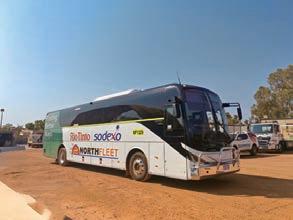

A change in focus will see GoZero Group turning its attention to growing its BusTech and Nexport brands in Australia
Riding off the back last year’s BusTech acquisition, GoZero Group has announced the strategic divestment of its 50 per cent share in Foton Mobility Distribution (FMD).
The shares have been sold to FMD joint owner and CEO Neil Wang and bus industry veteran Scott Riley, who sold GoZero Group his North Sydney Bus Charter business in 2023.
The sale of FMD to Wang and Riley will allow GoZero to focus on building towards its goal of being Australia’s largest Australian owned manufacturer of battery electric buses through its Nexport and BusTech brands.
In September last year, GoZero acquired BusTech Group, including its pre-existing factories in South Australia and Queensland.
“GoZero Group is now able to fully focus on investing in its domestic capability to rapidly grow its Australian bus manufacturing business under the Nexport and BusTech brands. Our future local manufacturing strategy is clear,” GoZero Group executive chairman Stephen Cartwright OAM says.
Having successfully completed the acquisition of NSBC in 2023 and then doubling its revenue by offering high quality electric buses and coaches, particularly for schools, Cartwright says GoZero is now focused on completing the BusTech acquisition with the same success.
Once complete, he says the BusTech acquisition will position GoZero as the largest Australian owned bus manufacturer in the country. With established factories in Adelaide, Brisbane and Western Sydney, and plans for future expansion into Victoria, GoZero Group is dedicated to building a truly national “Australian Owned, Australian Made” bus manufacturing and charter business.
“This local manufacturing capability will support state and local governments, and private bus operators, with access to world class
zero emission buses made right here in Australia using local supply chains and creating secure jobs for Australian workers for decades to come, including the employment of highly skilled apprentices,” he says.
The transaction ends a four-year partnership between the parties, with FMD announcing Riley will now join the board as a director. He brings with him decades of experience in the industry, having grown NSBC before its sale to GoZero in 2023.
“I am looking forward to continuing a long-term association with Neil Wang and the FMD team,” Riley says.
“With Neil’s undoubted enthusiasm for the zero-emissions transition, and my experience founding, building and running a 250-bus fleet, I believe together we can elevate the customer experience to new heights.”
After being one of four companies to be awarded a contract to run
battery electric city buses to Transport for NSW, FMD and its associated entity KRW Hydron will open a new facility in South Nowra, NSW, to assemble and deliver 126 buses between June 2025 and January 2027.
GoZero’s manufacturing subsidiary, Nexport, supplied the first 60 battery electric city buses to Transport for NSW (TfNSW) in 2021. Since then, these electric buses have travelled millions of kilometres transporting commuters throughout Sydney.
Nexport electric buses and coaches are also currently operating in regional NSW under a TfNSW Regional ZEB trial, which is examining the best zero emission bus solutions for commuters in regional towns and cities.
Nexport is an approved supplier of battery electric buses on TfNSW’s Bus Procurement Panel 4.



Discover the ultimate in coach design with our BCI Cruiser bodies, built to fit a variety of European chassis platforms with cutting-edge safety technology, specifically engineered to meet the unique demands of Australian roads. Step into their refined interior designed for maximum comfort, with spacious seating and climate control tailored to enhance every ride. This new generation of BCI coaches sets a new standard of excellence in our industry.




Contact our team for further information on 1300 289 224 or visit bcibus.com.au
Head Office Perth: 08 9353 9000
Melbourne: 03 8787 2100
Brisbane: 07 3275 6900
Adelaide: 08 8182 3888
BIC’s new executive director has decades of experience liaising with political parties and is well-known to many in the local bus industry
Varenya Mohan-Ram has been appointed as the organisation’s new executive director, becoming the face of Australia’s national bus and coach body.
Mohan-Ram is well-known to the Australian bus and coach industry through his years of support and advocacy, having previously presented various high-level topics at past BIC and state association events.
Varenya took the helm at the BIC on Monday, April 7.
He brings more than 30 years of experience in strategic management, government and cross-sector experience to the role, having worked across multiple transport sectors including bus, aviation, road, waste, furniture removal, warehouse and refrigerated transport.
“I am truly humbled to be chosen as the BIC ED. I have worked closely with the bus industry for the past 12 years and even closer in the past five years, delivering superannuation services via TWUSUPER, now TEAM Super,” Mohan-Ram says.
“In the time I’ve worked with the bus sector, I have felt great respect for the individuals who provide such an important community and economic service for Australia. The strength of the BIC team and its council attracted me to contribute my ideas for the betterment of the bus industry.
“I look forward to your ideas, your knowledge and guidance in helping me shape a better tomorrow for our sector.”
His most recent role was as the national business relationship manager at Team Super (formerly TWUSUPER Fund), which saw him become the corporate liaison for the largest transport and logistics companies contributing to the fund.
Throughout his career, Mohan-Ram has also been the national executive member of the Australian Labor Party between 2011 and 2013 and headed up the Northern Territory branch as general secretary. In the corporate
world, he has also stood on the boards of organisations such as the Warehouse & Transport Association of Australia, the Service Industry Training Advisory Council, Asthma Australia (NT) and the Association of Superannuation Funds of Australia, of which he was chairman.
He holds a Bachelor of Science, a Diploma of Financial Services in Superannuation, a Master of Business Administration (MBA) and a Finance for Senior Executives from Harvard Business School.
BIC Council chair Tony Hopkins says the organisation is excited to move forward on a number of initiatives in 2025 with their new chief, including the National Conference in Perth later this year.
“I hold Varenya in the highest esteem. He’s well respected and his many years of involvement within the bus and coach industry, including with the BIC directly, will be pivotal in
growing the organisation’s reputation and reach,” Hopkins says.
“I sincerely congratulate Varenya and look forward to working together. I’ve no doubt that his strategic background will serve to help bring about some long-awaited changes.”
His first official engagement as the BIC executive director was at the Queensland Bus Industry Council (QBIC) Annual Conference in Cairns in April where he was speaking. QBIC executive director Jason O’Dwyer welcomed Mohan-Ram’s appointment.
“Varenya has made significant contributions particularly through his role at TWUSUPER where he has been instrumental in driving industry engagement and assisting develop the transport industry,” O’Dwyer says.
“His expertise and passion for transport superannuation education and leadership will add enormous value to our event.”


Irizar’s iService Portal is an advanced digital platform with technical data simplifying complex maintenance processes and ensuring fleets remain operational with minimal disruptions.
Simply enter your VIN for:
Comprehensive Technical Documentation
Precision Spare Parts Ordering
Maintenance Resources

Registering for iService is easy—simply click the “Register Yourself” button on the iService Portal at https://iservice.irizar.com









The new CEO brings decades of leadership experience to the role in both the
The National Heavy Vehicle Regulator (NHVR) has announced its new CEO, with Nicole Rosie named as the successor to Sal Petroccitto.
NHVR chairperson Duncan Gay AM announced the appointment earlier this month, saying Rosie brings “a wealth of knowledge and experience” to the role.
Rosie starts in her role at the NHVR on June 30 this year.
“I am pleased to announce Ms Rosie was selected as the new NHVR CEO following an extensive and rigorous recruitment process,” Gay says.
“With over 20 years of leadership experience in both the public and private sectors, most recently Ms Rosie was the CEO at New Zealand Transport

“Ms Rosie’s strong background in governance, law and public policy, combined with a deep understanding of transport and infrastructure, made her the ideal candidate to lead the NHVR into its next chapter of harmonisation and innovation.”
Gay has also extended his sincere thank you to interim CEO Janelle van de Velde.
“I would like to thank Janelle for her outstanding leadership during this transition period and for ensuring business continuity following former CEO Sal Petroccitto OAM’s departure in January,” he says.
Gay says van de Velde will remain as the interim CEO until Rosie commences with the NHVR on June 30.
BusVIC
The new executive director has been serving as BAV’s general counsel for the last 15 years and is an ‘outstanding fit for the role’
BusVIC has announced that long-time member Chris Lowe will be resigning from his position as executive director of the Board of the Bus Association Victoria Inc. (BAV).
His duties will officially end on June 30, 2025 as he semi-retires and moves on to chair BAV’s related entities on a part-time basis for the 2025/2026 financial year only.

During his 17 years at BAV, Lowe has led two decades worth of metropolitan and country contract negotiation regimes for operators, undertaken important research and policy development, and advocated same to all levels of government.
“Chris has materially diversified BAV’s commercial interests and increased the net assets of BAV six-fold,” BAV president Stuart Locke says.
“The BAV Board congratulates Chris for a significant and progressive 17 years and sincerely thanks him for his contribution to both the BAV and the broader bus and coach industry.”
In the same statement, BusVIC announced that Peter Kavanagh will be stepping into the role as the new executive director after serving as BAV’s general counsel for the last 15 years.
Well-known to industry stakeholders, Locke says Kavanagh has a sound knowledge of the workings of BAV, an intimate understanding of the needs of the industry, the current strategies in place, and will be an outstanding fit for the role.
“The BAV Board warmly welcomes and congratulates Peter on his appointment to the BAV executive director’s role,” Locke says.
“We will provide Peter all the support necessary to succeed in his new endeavour and ensure positive outcomes for members and suppliers in line with BAV’s vision, mission and strategy.”
Peter began transitioning into the role from April 2, allowing a three-month period to ensure knowledge transfer and business and strategic continuity.
The state is powering towards its transport emissions goals, with the new fleet to be powered by a well-known manufacturing combo
The South Australian government has announced it has ordered 60 brand new 100 per cent full battery electric buses and revealed plans to create a zero-emissions passenger transport network.
The new bus fleet bodies will come with a Scania chassis and a Volgren body, with the infrastructure to charge the buses to be installed at the Morphettville depot.
The buses will be delivered progressively throughout the second half of this year and the start of 2026, with there currently only being the one trial full battery electric bus operating on the state’s bus network.
Alongside this, the SA government has also appointed two global engineering advisory firms to
develop detailed planning for creating a zero-emissions passenger transport network.
Mott MacDonald and WSP will help develop the detailed business cases to plan towards the zero-emissions operations that will span across both bus and passenger rail networks.
This work will consolidate the large body of planning and feasibility analysis already done by the state government.
It also follows a series of meetings held by SA infrastructure and transport minister Tom Koutsantonis with some of the world’s biggest rail companies at Berlin’s InnoTrans 2024 to focus on rolling out more battery electric trains in the state.
The Adelaide Metro bus fleet currently consists of just over 1000 vehicles powered by a mix of diesel, hybrid, battery electric and natural gas powertrains, with two hydrogen buses currently on trial. As of September 2022, procurement of new diesel-only buses has ceased, and all new vehicles are now either diesel-electric hybrids or battery electric.
With transport being the largest single source of emissions in the state and the state government committed to reducing emissions by at least 60 per cent of 2005 levels by 2030, the business cases are expected to be completed early next year to allow for the roll-out of more green buses in South Australia.


The state association says the event will be held on Wednesday July 15 and Thursday July 16 next year at The Dome and Halls at Sydney Showgrounds.
BusNSW executive director Matt Threlkeld has confirmed it’ll once again host the premier industry event which forms part of a four-year cycle and follows the successful 2022 expo held in Sydney.
“The dates have been carefully selected after considering NSW school holidays, venue availability and other key industry events,” he says.
“Our goal is to maximise attendance by operators and provide attendees with the opportunity to experience the latest advancements in bus and coach technology, including zero-emission transport solutions.”
The Expo will feature over
13,000 square metres of displays, showcasing the latest vehicles, technology and innovations across the passenger transport sector.
Leading manufacturers and suppliers will demonstrate the latest products and services, with a strong focus on enhancing safety for drivers, passengers and the community.
“The timing of the Expo aligns with the fleet procurement pipeline associated with the Greater Sydney Stage 1 Zero Emissions Bus Program, as well as continued fleet replacement orders for outer metropolitan, and rural and regional bus services in NSW,” Threlkeld says.
“Additionally, strong growth in the tourism and charter markets is driving increased demand for new buses and coaches, making July 2026 an ideal time to display vehicles.”
BusNSW anticipates strong engagement from operators, suppliers and government agencies, positioning the Expo as a must-attend event for domestic and international industry stakeholders.
“We will soon commence discussions with our partners, associate members, and industry suppliers regarding bookings for booths and vehicle display areas,” Threlkeld says.
The Expo will also feature two networking events, including a welcome function in Tuesday July 14 and an industry dinner on the night of July 15.
“If buses or coaches are your business, mark Wednesday 15 and Thursday 16 July 2026 in your calendar and start planning your visit to Sydney for the Expo,” Threlkeld says.
The Yutong Australian distributor has welcomed industry veterans and restructured its national sales and aftersales network

The distributor says the restructure allows VDI to reinforce its promise to Australian operators to provide reliable advice, seamless delivery and long-term support.
The addition of two well-known industry people in Robert Smart, previously from air-conditioning supplier DENSO, and Logan Hoser, who spent 20 years at Scania Australia, is part of the shuffle.
“This is more than an internal reshuffle – it’s a reflection of how VDI is preparing its people, processes and partners for a transport landscape in transition — whether operators are trialling electric for the first time, expanding a full zero-emission fleet, or looking for proven performance with Cummins Euro 6 diesel technology,” VDI Australia says in a statement.
VDI’s restructured national sales team is built around the idea of delivering deep regional knowledge combined with nationally aligned support.
Each region is now supported by business development managers
and account managers, backed by a national sales operations specialist to keep communication smooth and customer needs on track.
From seasoned leaders to strategic new appointments, VDI national sales manager Sara Clark says each person has been chosen to meet the specific needs of customers in their region.
“While our newly structured team brings together over 235 years of combined industry experience, this shift isn’t about looking back — it’s about being ready for what’s next,” Clark says.
She says Hoser and Smart bring “fresh energy and strong reputations” from their regions, with their arrival coinciding with the transition for long-time sales leader Peter Verbrugge to a strategic business development manager role across Victoria, South Australia and Tasmania.
Also part of the shuffle is the move of Brendan Godber from leading the aftersales division to taking up a business development role.
Out west, VDI’s national footprint includes Mike Kennedy and Scott Lane in Western Australia.
“This team’s experience spans real-world operations, fleet planning, compliance and delivery — giving us the insight to ask smarter questions early, anticipate the challenges our customers face, and support them through every stage of the journey,” Clark says.
“It’s that blend of practical expertise and forward focus that makes the difference, especially as operators navigate fleet transitions and shifting regional requirements.”
VDI has also built a responsive service package for regional areas, with the company investing in structure that includes onboarding guides, training videos and technical documentation.
This shift is led by Sam Gibson, who recently joined as national service manager following Brendan Godber’s move into sales.
“Our goal is to ensure the sales journey transitions seamlessly into long-term support,” Gibson says.
“That means making it easy for customers to access the information, training and service they need — wherever they are.”
The national restructure has allowed VDI to better match its growing product portfolio — from battery-electric buses to proven Cummins Euro 6 models — with a team built to support operators across the full lifecycle.
And while the vehicles may be front and centre, Gibson says the people behind them are the difference between a one-time deal and a lasting partnership.
“VDI is not just focused on getting customers into the right bus — the team is committed to supporting operators through the entire journey. From planning and delivery to long-term performance, VDI is there to help drive the future forward,” he says.
The Banyo depot can accommodate up to 40 vehicles at full capacity, with onsite refuelling, washing and basic services facilities
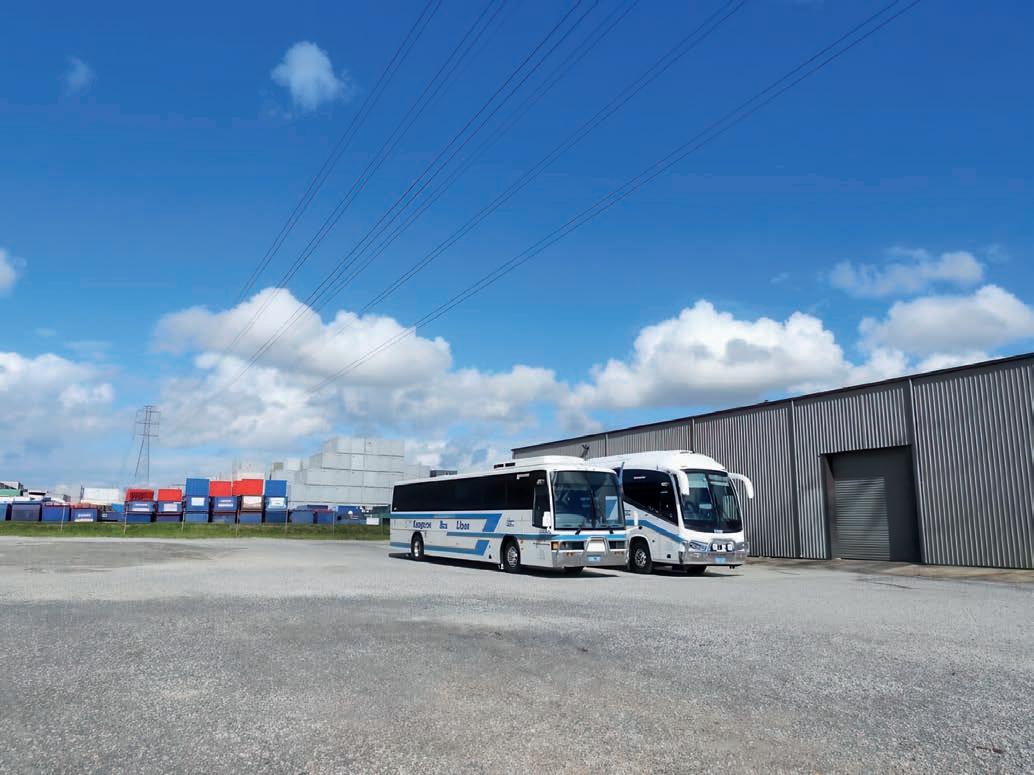
Bus operator Kangaroo Bus Lines, in an effort to expand its capabilities across Queensland, will soon open a second satellite depot in Brisbane.
Opening it doors this month, the additional depot in the inner Brisbane
greater efficiencies to its clients.
suburb of Banyo aims to grow the operator’s tour and charter business.
“We are extremely excited to find a good, suitable location in this northern part of Brisbane to strengthen our charter business and
deliver greater efficiencies for our clients as we continue to grow this division of the KBL brand,” Kangaroo Bus Lines CEO Darren Webster says.
“The growth we have experienced in recent years supports this strategic placement of our new depot location and assists us in better servicing our Brisbane based clients and customers, along with the work we regularly perform at the Brisbane International Cruise Terminal.”
The Banyo depot will accommodate up to 40 vehicles at full capacity, with onsite refuelling, washing and basic services facilities, along with an office and full driver amenities.
“One of the big advantages we see with this new site is the efficiencies we can pass on to our customers,” Webster says.
“Our coaches will no longer have to sit in the already congested road network travelling to and from our Burpengary head office.”
Managed by a dedicated team based at Banyo, the new depot forms part of the larger Kangaroo Bus Lines business, underpinned by the Burpengary Head Office and secondary Sunshine Coast depot.
“KBL looks forward to offering our clients and customers enhanced transport and logistical solutions from Brisbane City right through to the Sunshine Coast,” Webster says.

T (07) 3344 4544 E coachworks@royans.com.au www.royans.com.au











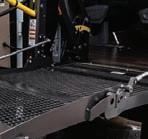
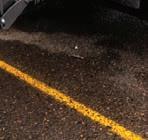


Following the recent resignation of Jo Haylen, the New South Wales government has announced its new transport and roads ministers
John Graham, who was the roads, jobs and tourism and arts minister, was appointed interim transport minister in the wake of Jo Haylen’s recent scandal and will now take the transport reins full time. He will also be maintaining roles for special minister of the state and arts, music and night-time economy minister.
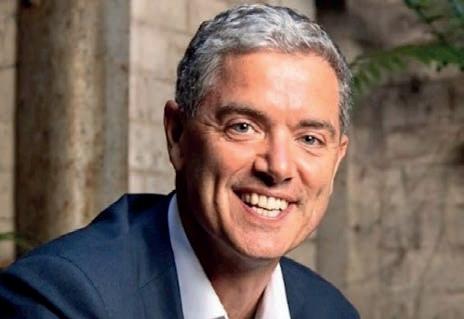
Graham will also continue to take carriage of the government’s response to the toll review given it is in the midst of negotiations with toll companies about reforming the system.
The roads portfolio, however, will now be handed to Jenny Aitchison, who will also retain her regional transport ministership.
“As a regional MP Jenny Aitchison is well placed to ensure the needs of regional and rural communities are met,” Premier Chris Minns says.
Steve Kamper will be sworn in as the jobs and tourism minister, in addition to his responsibilities as the lands and property minister, the multiculturalism minister and
sport minister.
Lismore MP Janelle Saffin, who’s held the seat in the state’s north since 2019, has been promoted to cabinet for the first time to take on the disaster recovery, small business and north coast portfolios.
Emily Suvaal will also be appointed as the parliamentary secretary for trade and small business where she will be supporting ministers and driving action to deliver on government priorities in Parliament.
“These are important changes to the NSW Ministry that will ensure we continue to invest in essential services that people rely on, and build a better NSW,” Minns says.
Former Kelsian Group CEO Clint Feuerherdt will remain a valued part of the business in a strategic advisor role
Transport operator Kelsian Group has announced the appointment of Graeme Legh as its new CEO, leaning on his 15 years’ experience with the group.
Legh will be taking over the role from Clint Feuerherdt, who has spent the last 15 years transforming Transit Systems and then SeaLink into what is now known as Kelsian Group.
Kelsian Group chair Fiona Hele says while stepping down as CEO, Feuerherdt will remain a valued part of the business in a strategic advisor role.
“With many thanks to Clint for his commitment and determination in growing the business, we are pleased to retain his broad expertise and experience, while also supporting his personal goals for the next phase of his career and balancing his work and family life,” Hele says.
“His knowledge and significant global experience are invaluable

to our group, and he will focus on key strategic projects that optimise our portfolio and enhance business performance.”
Legh says essential transport is “the backbone to smart and successful cities across the world” and he looks forwards to contributing to the future.
“Having worked alongside Clint for the past 15 years, I step into this role with a deep understanding of
all aspects of the business and with a commitment to continue delivering results,” Legh says.
“I am proud to lead Kelsian into its next phase of success.”
Hele says Kelsian is well-positioned for ongoing future success.
“This business has always been about people, innovation and delivering world-class transport solutions,” she says.
“From winning Australia’s first franchised tender, to transitioning more public transport contracts than any other operator, while delivering Australia’s largest electric bus depot and fleet, we have continued to set new benchmarks.
“With our strategic succession plan in action, Graeme takes the helm, supported by an outstanding leadership team.
“We’re excited to keep moving forward.”
Dubbed The Wave, the new transport system will carry passengers from Beerwah through to the Sunshine Coast Airport via rail and bus
A new “seamless public transport” link for the Sunshine Coast has been announced as part of the 2032 Olympic Games Delivery Plan.
The state government has announced the region will be connected from Beerwah through to the Sunshine Coast Airport, with a major new rail and metro connection called The Wave.
Passengers will travel on the rail line from Beerwah to Birtinya, then metro bus to the airport with stations at Mountain Creek and Maroochydore.
Infrastructure will be constructed from the Birtinya station to the Maroochydore station, via the long-awaited Mooloolah River Interchange Upgrade project (MRIU).
“The Wave is something the Sunshine Coast can really get behind,” transport and main roads minister Brent Mickelberg says.
Below: There has been no announcement as of yet of which manufacturer will be behind the design and build of the ‘trackless trams’ or buses. Image: QLD government
“We are delivering seamless public transport further than what was initially planned, with commuters now able to travel past Maroochydore all the way to the Sunshine Coast Airport.
“By delivering metro, we are able to build the Mooloolah River Interchange which locals have been waiting for decades to see but has repeatedly been delayed by Labor.
“The Mooloolah River Interchange will ease congestion at the well-known traffic chokepoint on the Coast and will include two extra lanes on the Sunshine Motorway north of Kawana Way, which is long overdue.”
The state government stated that it would build the interchange as a priority to remove congestion and allow The Wave to carry commuters without delay
The new buses slated to carry passengers across the corridor
resemble the Brisbane Metro service that began service earlier this year.
There has been no announcement as of yet of which manufacturer will be behind the design and build of the ‘trackless trams’ or buses.
Premier Crisafulli says The Wave would keep the Sunshine Coast moving, now and beyond 2032.
“The Games are a once-in-a-generation opportunity to deliver the infrastructure the Sunshine Coast’s needs, not only today, but in the decades to come,” Crisafulli says.
“The Wave will go further and faster, with seamless public transport all the way to the Sunshine Coast Airport and connect to the Athlete Village built for the Games.
“This is exactly what is needed for 2032, but more importantly, it is necessary for the future of the Sunshine Coast beyond the Games.”
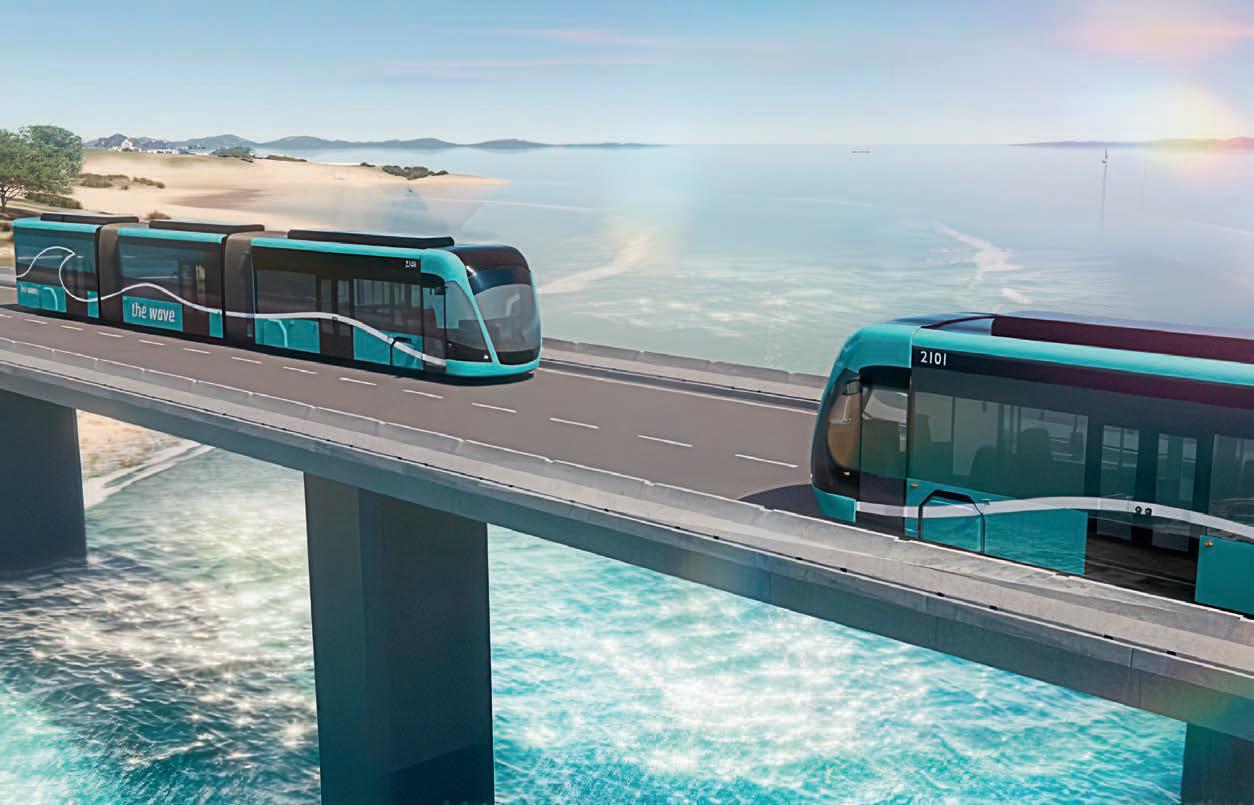
An incident where a bus rolled away before running over and seriously injuring its driver has prompted a warning from SafeWork SA Above: Heavy vehicle operators are being urged to be careful regarding potential vehicle rollaways. Image: Phoebe/ stock.adobe.com

The incident occurred on February 20 after the driver stopped the bus to inspect it, and it rolled about 10 metres down an incline, knocking her down and rolling over her. SafeWork inspectors attended the scene and enquiries are continuing.
There have been four South Australian deaths where workers have been struck by a roll-away vehicle since 2020 and in the same period, there have also been 12 serious injuries and eight reports of property damage caused by vehicle roll-aways.
“Vehicle roll-away incidents in South Australia were almost always preventable,” SafeWork SA executive director Glenn Farrell says.
“Eliminating the risk of a vehicle roll-away should be a priority for all businesses and drivers, given the devastating consequences that can eventuate.”
A roll-away incident involves the unintentional movement of a vehicle because it has not been safely immobilised. In most incidents the predominant cause is that the handbrake has not been engaged or is ineffective.
Roll-aways can occur with any type of mobile plant including cars, forklifts, trucks, tractors, trailers, passenger vehicles and heavy machinery. Roll-aways can occur on worksites, car parks, maintenance yards or when a vehicle is parked on the side of the road.
This can include when the vehicle brakes are not adequately applied or engaged, when doing repairs on the vehicle, during loading and unloading, or when coupling or uncoupling a truck and trailer. Vehicles, that have not been safely immobilised roll-away, create a risk to people who could be hit, crushed, trapped or run over, leading to serious injuries or fatalities. Injuries can also occur when a person tries to enter or exit a vehicle that has begun to roll-away.
“This is a reminder to businesses to ensure immobilising and braking systems are fully maintained and operational on all types of vehicles, and to drivers, for everyone’s sake, apply the break,” Farrell says.
A range of the world’s largest bus manufacturers and suppliers have teased new model announcements occurring at the event
There is just six months to go until Busworld Europe 2025 takes over Brussels, Belgium, showcasing leading bus and coach technology from around the world.
Bus manufacturers and component suppliers have started teasing what they will unveil at the show, ranging from electric and hydrogen vehicles to next-gen drivetrains and telematics.
In the vehicle space, MAN Truck & Bus will release two major premieres at Busworld Europe, including its maiden fully electric touring coach, the MAN eCoach, and the second generation of the MAN Lion’s City 12 E electric city bus.
Solaris Bus & Coach will unveil the Urbino 12 Hydrogen 2.0
Below: There is only six months lef t to go before Busworld Europe. Image: Busworld
second-generation hydrogen bus, while VDL Bus & Coach is expected to launch a new generation of its Citea electric platform.
Irizar’s e-mobility offerings will
include a redesigned ie tram, with BYD announcing the European debut of a new electric city bus featuring solid-state battery technology.
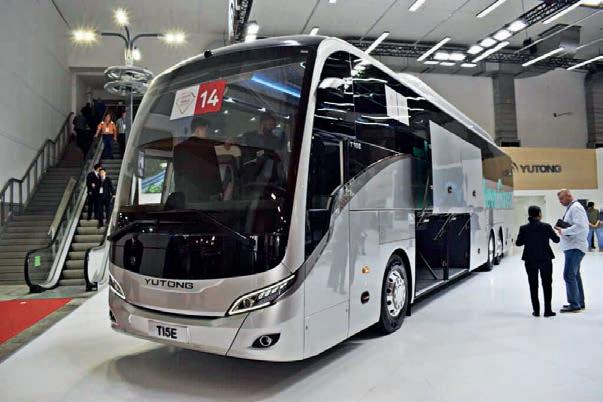
Emerging Vietnamese company VinFast will make its European debut at Brussels with a 12m electric city bus, while Chinese OEM Alfabus will have two electric bus models and Spanish manufacturer UNVI will launch its SIL Electric low-entry coach.
In the supplier sphere, ZF will present the latest evolution of its integrated electric axle, Voith will expand its eDrive portfolio and ACTIA Group will showcase an updated telematics suite.
Busworld says momentum is already building, with more launches teased to come later this year.
Auckland Transport is looking to update one of the busiest routes in the city, easing congestion and making the road safer
Onewa Road is set to become “more productive”, with plans to introduce bus boosters and queue detection technology to help ease congestion.
About 30,000 vehicles travel along Onewa Road every day, with the road currently made up of two lanes each way and transit lanes.
“Residents and businesses here rely on Onewa Road every day, and it’s important it is efficient for our growing community,” North Shore councillor Richard Hills says.
“As a regular bus user, I see how efficient the T3 is at moving over 65 per cent of morning commuters in that lane, but we need to continue to provide improvements for all users at all times of the day.”
There has been a continued increase in the number of bus services
using Onewa Road, most recently with the upgrade of the popular 94 bus to a frequent service connecting Beach Haven, Birkdale, Birkenhead, Northcote, and Takapuna with trips every 15 minutes, 7am till 7pm, every day of the week.
Auckland Transport’s plan includes implementing bus boosters and queue detection technology. The innovative system uses real-time GPS data from buses to prioritise green lights for late-running buses, helping them catch up on schedule and reduce wait times for passengers.
“While the T3 lane is for buses and vehicles with three or more occupants, by making the road more productive at moving more people, it results in better journey times for all road users,” road
network optimisation manager Chris Martin says.
The plan also includes a shared path for pedestrians, cyclists and e-scooter users, and improved technology at pedestrian crossings adjacent to the three schools on Onewa Road.
Northcote MP Dan Bidois says the changes will provide relief for all passengers.
“Let’s be clear, this is not a rebuild, this is simply making the most of the space already there on Onewa Road to ease the burden of congestion and to make the road safer for the tens of thousands of people who use it every day,” Bidois says.
Feedback on the changes is now closed, with the aim being to deliver most of the changes by the end of 2025.




In
the fast-paced virtual landscape of today, the relevance of in-person events is still in strong demand, especially so within bus and coach.
The reason lies in the profound impact that coming together can have on us as individuals, businesses, stakeholders and communities
Events are among the most effective strategies used by business-to-business industries, of which our sector is a part. Studies even show that 74 per cent of delegates have a more positive perception of an organisation after an event and, as consumers, 96 per cent who have a great experience are more inclined to open (and close) deals afterwards.
Events play a crucial role in promoting engagement, providing social interaction and creating memorable experiences. They are dynamic platforms where ideas converge, connections flourish and growth, innovation and collaboration catalyse. Their ability to bring people together and foster communication transcends the limits of virtual events.
“Ubuntu [the essence of being human] speaks about our interconnectedness,” Bishop and theologian Desmond Tutu says.
“We think of ourselves far too frequently as just individuals, separated from one another, whereas you are connected and what you do affects the whole world. When you do well, it spreads out...”
With the multitude of transport events happening this year, not to mention those within the Bus Australia Network (BAN), it may be timely to remind ourselves of this essence or importance of being interconnected.
1. Power of face-to-face: We’re dominated by emails, video calls and instant messaging daily; in-person gatherings provide a unique opportunity for genuine, personal connections.

ing-sharing: Knowledge-sharing opportunities via insightful keynotes, workshops or panel discussions offer access to a concentrated pool of expertise that can accelerate learning and expand perspectives.
3. Beyond networking: Digital networking has its place, but live events offer what screens can’t – coffee breaks and social get-togethers, perhaps over a tipple or two! These provide fertile ground for spontaneous connections and collaborations, leading to partnerships, innovations and business opportunities.
4. A sense of community: Whether local or across the pond, participants share a common interest or purpose that create personal and professional relationships, and valuable support networks.
5. Credibility-building: When organisations actively participate in or host gatherings, they position themselves as thought leaders and industry experts which builds trust and credibility.
6. Insightful: Events generate a wealth of attendee facts, all valuable to better understand the people
has plenty of events prepared throughout 2025.
our sector.
From April 2025, you can look forward to the following BAN conferences and major events in a city near you:
• M ay 16-17– BusSA Conference (Adelaide, SA)
• M ay 31 – TasBus AGM and Networking Event (Campbell Town, TAS)
• July 18 – BusWA BCI Bus Show (Perth, WA)
• October 1-2 – BusNSW Conference (Hunter Valley, NSW)
• October 29-31 – BIC National Conference (Perth, WA)
Get in touch directly to find out more about state association events and how you can do your bit by supporting your local BAN member via partnering or attending. In the end, live bus and coach events still matter because their essence celebrates bussie connection on every level. When we recognise and embrace the lasting significance of these events, we can be at the forefront of innovation, community building and brand success in today’s ever-changing interconnected landscape.
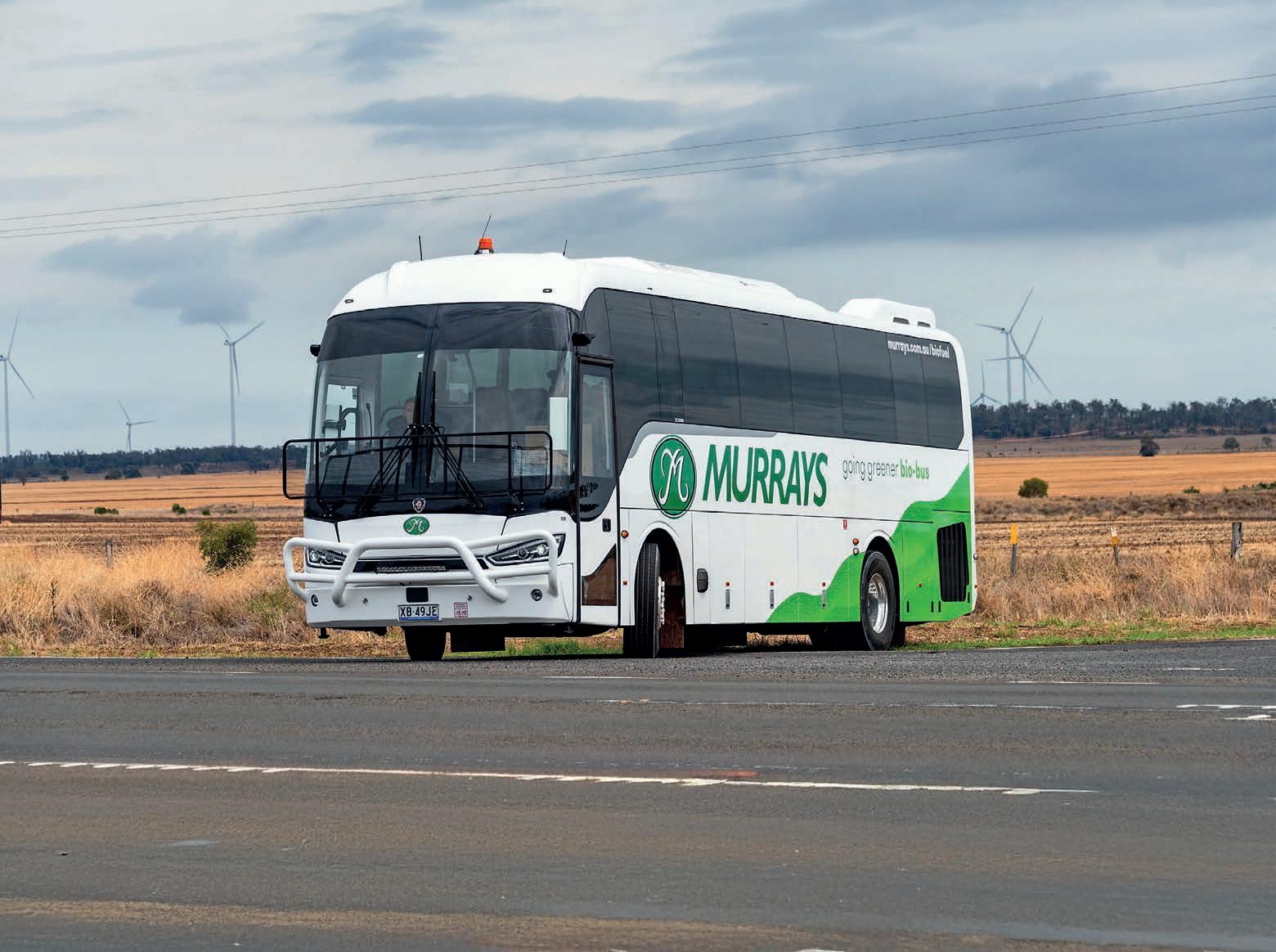
Sales for BCI’s popular Cruiser model are on the rise. Tiarna Condren finds out what features are making operators fond of the dynamic model
In the fast lane of Australia’s bus and coach industry, going it alone is old news. These days, it’s all about teaming up, thinking big and building smarter.
When manufacturers join forces, designs get sleeker, tech gets smarter and buses become more than just people movers; they become experiences on wheels.
One standout example of this collaborative spirit is the BCI Cruiser.
For decades, Bus and Coach International (BCI) has been supplying top-of-the range buses and coaches that combine the best chassis and body combinations.
Now, the company is offering its customers the opportunity to have their Cruiser set up on either a Volvo or Scania chassis, depending on which of these European manufacturers the operator prefers.
With BCI’s design and body-building expertise, coupled with the proven chassis engineering from either Volvo or Scania, the Cruiser sets a new standard for reliability, comfort and efficiency on Australian roads.
Planting the seeds of a relationship at the end of 2022, Scania Australia public relations manager Alexander Corne told ABC the company was drawn to BCI’s “positive, can-do attitude”.
“We chose to partner with BCI because we were looking for a reliable and quality-focused partner with which to expand our footprint in the school bus and charter market and to provide additional volume alongside our existing chassis and fully imported products,” Corne says.
“Scania is always happy to work with partners who have credibility
Above: It was the flexibility of the model that drew Murrays to purchase a Cruiser
and market presence, as well as high quality products that will deliver the uptime Scania customers have come to expect.”
For Volvo, the selling point came when a customer requested a bespoke solution that BCI was able to fulfill. Combined with the B8R Volvo platform, they created the “perfect solution”.
“It was evident from that point forward that the two teams worked together seamlessly,” Volvo Bus APAC director of product and industry bus Mark Fryer told ABC
“Both BCI and Volvo engineering teams spent many months developing a compliant and operationally correct vehicle for the customer. This included the Volvo engineering team visiting BCI in China to see the buses in production and engaging with the customer throughout the process.

“It was a very good example of a collaboration between OEM and external body builder, and something that we wanted to continue moving forward.”
The BCI Cruiser body had previously been sold with its own or external brands of chassis. With successful collaborative efforts already under its belt, when BCI wanted to revamp the Cruiser offering to customers, bringing European OEMs into the conversation was a no-brainer.
“A lot of operators are looking for innovative solutions that exceed what is currently offered on the market,” BCI Australia sales development manager Armando Baylon told ABC
“One of the main attractive factors when an operator is considering the purchase of a BCI Cruiser with a Volvo or Scania chassis is the technology and safety that it guarantees.

“European OEMs are often engineering designs that are ahead of the game and, coupled with the body and aftersales support from BCI in Australia, it’s incredibly appealing.
“The combination of the innovative body with a really prestigious chassis under it is a winner.”
When operators are deciding between manufacturers for its next purchase, most are very careful to choose a supplier that has a strong network for aftersales. Particularly in areas like Western Australia, ensuring vehicles can be repaired remotely and with good staff is a major consideration when splashing the big bucks.
“Operators will be very careful to
decide which manufacturer will really support them when things go the other way around,” Baylon says.
“They need to not only consider the vehicle’s bells and whistles, but who will continue to work with them after the sale to keep updating and servicing the bus.”
In the first 18 months since launching the collaborative model, over 150 units have been built, with operator interest on the rise.
A major selling point of the Cruiser has been the model’s flexibility and adaptability, each manufacturer willing to make changes to the model to better suit the needs of its customers.

Below: The BCI Cruiser can be adapted to suit almost any application
While the BCI Cruiser was originally conceived to serve as a long distance or luxury coach solution, operators across the country are opting to dedicate the buses to other applications.
In Western Australia, operator Go West Tours has a long-standing relationship with BCI that has led to the purchase of over 100 BCI vehicles. Now, the operator has turned its head to the Cruiser model.
“Go West approached us and asked if it would be possible to create a bus to be used in mine sites that would combine the international chassis with BCI solutions,” Baylon says.
“We worked closely together
to create a tailored solution to suit their needs, bringing together the expertise from our engineers with their hands-on driver and passenger experience.
“Some of Go West’s ideas were so creative that we ended up implementing them in the base model.”
Starting with an initial test of three units, Go West soon ordered another 10, and have expressed interest in the possibility of more.
“With every delivery, we keep
in its fleet, BCI Queensland state manager Andrew Dosa told ABC Murrays is more than happy with its purchases.
“We’ve been working with Murrays for 16 years now and have an incredible relationship with them,” Dosa says.
“We know what they expect from us and we always find a way to deliver what they are thinking up.”
Initially attracted to the body of the Cruiser, the larger door entry area and
using the technology in Australia.
“The feedback we have received from them has been overwhelmingly positive,” Dosa says.
“They love the wow factor of how the body looks. Everyone really loves the way it’s presented.”
The Cruisers are currently in service across New South Wales, Canberra, Victoria and Queensland, with the Brisbane, Chinchilla and Toowoomba buses already clocking up plenty of kilometres.

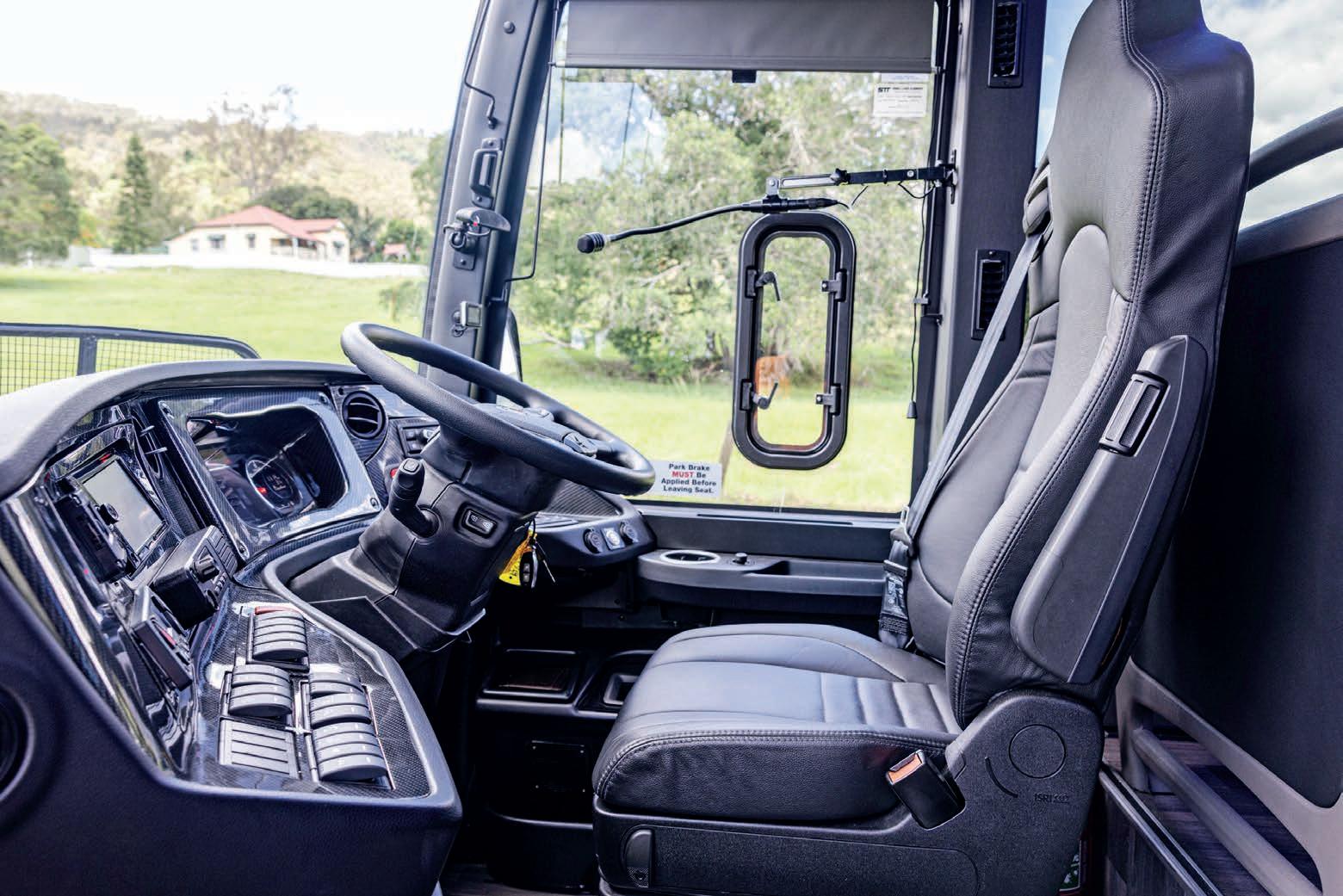
very competitive market.
“A lot of Victorian operators have high standards and expectations,”
BIC Victoria sales executive Paul Kennedy told ABC
“They know exactly what they want, and they wouldn’t go with a manufacturer if they weren’t certain these expectations could be met.”
Kennedy says Popes was no exception, having a clean-cut idea of exactly how the Cruiser should be.
“They wanted choice over the seating, air-conditioning and even air bag protection,” Kennedy says.
“We were able to design and accommodate these in conjunction with the customer and our factory.
The communication between all involved was exceptional.”
designed for Australian roads and conditions.
Kennedy says it is quite “rare” for operators to have this much of a hand in the design.
“Customers are genuinely listened to in the initial stages, and we work very closely with them, the OEMs and our own engineers to see what we can improve and how we can make it the best product for them,” Kennedy says.
“It’s a testament to not only BCI’s relationship with customers, but our relationships with Volvo and Scania.”
Scania’s Alexander Corne says the combination of the Scania chassis and drive train and the BCI body makes for a successful product that delivers reliability, durability and high uptime for customers.
customers,” Corne says.
“We believe the relationship has been advantageous for BCI as well, as they have ambitious goals for this market.”
Volvo’s Mark Fryer says Volvo and BCI are always working to improve products and will continue to do so with the feedback from customers and the industry.
“Market feedback has been very positive, which we are not surprised about at all,” Fryer says.
“It’s a great new product for certain sectors of the bus industry.
“We are currently working on something new at the moment and will continue to create new models based on the industry requirements.”

Below:
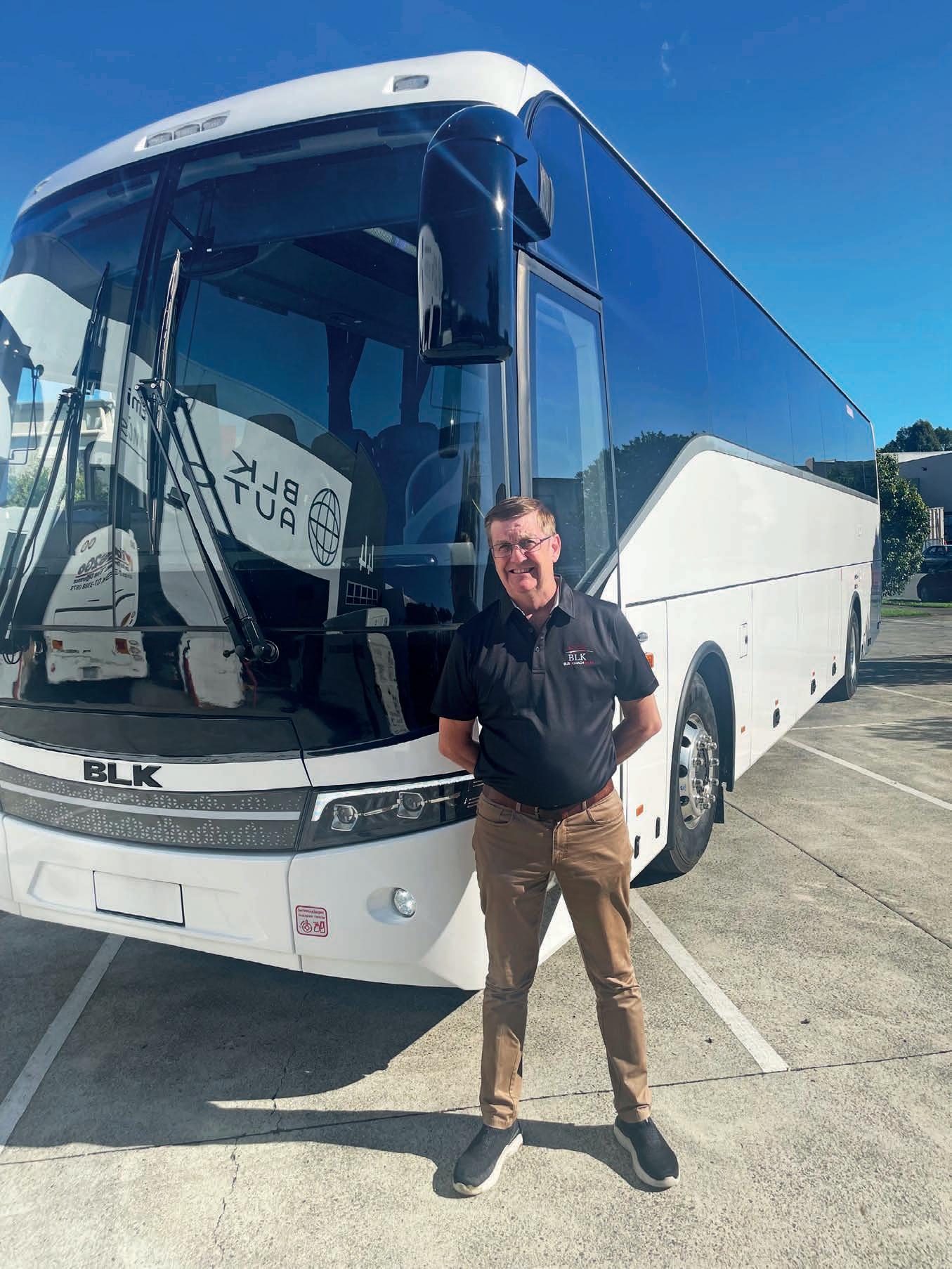
BLK Auto’s newest sales manager understands the importance of fortifying realtionships in the bus and coach industry
n the world of bus manufacturing, innovation, durability and reliability are non-negotiable. But behind every smoothly operating vehicle is something even more essential: people.
From design engineers and production line workers to marketing managers and sales executives, it’s the strength of the team that truly drives the business forward.
For BLK Bus and Coach Sales, having skilled, motivated and aligned team members isn’t just nice to have –it’s the engine that powers progress.
The bus manufacturer’s newest
hire, Don Imrie, is the epitome of these values, bringing not only three decades of experience to the role, but a passion that drives success.
Kicking off the role this month, Imrie will be based in Victoria, working as sales manager for Victoria, South Australia and Tasmania.
“I’ve been around buses all my life. When I was just a little baby boy, my father and my uncle had a bus business in Scotland,” Imrie told ABC “When I was growing up, I was washing and cleaning buses and cleaning wheels, doing whatever I could to get involved.”
Above: Don Imrie brings more than three decades of experience to his new role as sales manager for Victoria, South Australia and Tasmania
At the age of 17, Imrie and his family emigrated to Australia, where he soon began a career with the railways in Melbourne. Starting as a junior station assistant, he worked his way up through the ranks, ultimately becoming the youngest stationmaster in Victoria.
Despite a redundancy, Imrie was soon offered a pivotal role at Grenda Corporation, working alongside his father at Moorabbin Transit.
“My father has always been my best friend, even now I would still consider him that,” Imrie says.
“When the opportunity to work
alongside him popped up, I was overjoyed.”
Following the sudden passing of his father, Imrie transitioned to Grenda’s Dandenong Depot, taking on a new challenge in the charter department. He played a key role in growing Cardinia Transit, where he helped expand the fleet from 27 buses to 75 buses.
After 12 years, Imrie took his talents to the sales side of the industry with IVECO, where he forged lasting relationships that continue to endure today.
During his time at Iveco, he also started his own venture, Kingstons Tours, growing the company from just two coaches to a fleet of 30 buses. However, the impact of the COVID-19 pandemic forced a re-evaluation, leading Imrie to his next professional chapter with Yutong and later EBUSCO, where he worked with electric buses – a significant step in the industry’s shift from diesel to zero emission buses (ZEBs).
Unfortunately, EBUSCO made the decision to cease operations outside of Europe and Imrie was once again faced with redundancy.
Undeterred, he moved to Bus Stop Sales, taking on the role of fleet and relationship manager, before transitioning to BLK Bus & Coach Sales.
“With every job, I was able to take knowledge and experience and apply it to the next,” Imrie says.
“I bring a unique set of skills to the role, as I have been on many different sides of the industry. I can see things from the operator side of things, as well as the sales side.”
With his vast background in both operations and sales, Imrie says he understands the importance of reliability, aftersales service and maintaining strong relationships with customers.
He has witnessed first-hand the impact a bus off the road can have on operators, particularly small businesses, and is eager to bring his expertise and deep understanding of the industry to BLK Auto.
Jumping head-first into the role, Imrie says he is excited to get out into
the industry and rekindle relationships old and new.
“While I have a lot of relationships in this industry, there are always more out there that I can work towards,” he says.
“I’m excited for this new chapter of
Don has,” BLK Auto national sales manager Mark Nichols told ABC
“This industry is all about relationships rather than just going out and selling to people. I know he has quite a good relationship with not only the big players, but with a lot of






Scania Australia’s new Western Australian account manager will look to provide unparalleled service to customers
Buses and coaches are more than just vehicles – they’re lifelines for communities, connections between cities, and the beating heart of public transport. But behind every great bus is a team of people who design, build and sell them. And if those people don’t truly love buses, we all feel the difference.
Think about it: Would you trust a chef who doesn’t like food? Or a musician who doesn’t enjoy music? The same applies to the bus and coach industry.
When the people making decisions at manufacturers are passionate about the industry, when they’ve grown up fascinated by buses, or they genuinely care about passenger experience – everything changes.
That’s exactly why Scania’s newest Western Australia account manager, Darcy Grant, is such an exciting addition to the team.
With two decades of experience
in the bus and coach industry, Grant isn’t just another hire – he’s someone who lives and breathes the industry. His deep understanding of what operators need, combined with his passion for delivering top-tier vehicles and service, makes him the perfect fit for Scania.
“Over the past 19 years working for McConnell Seats I have built up a strong working relationship across the bus industry and I understand what operators want and need from their vehicles,” Grant says.
Having spent years working closely with operators, Grant knows that a great bus is about more than just its engine or fuel efficiency, it’s about the people who rely on it every day.
“I am very excited and enthusiastic about joining Scania, after starting at McConnell Seats as an apprentice motor trimmer and then graduating to sales around eight years ago, I think now is a good time for a career switch into a new area and sell the whole
Below: A Scania Touring bus in WA
product, not just one component,” he says.
Grant says he is familiar with the Scania brand through his previous role and will work hard to build relationships with operators out west.
“I will be moving to Perth to be a full-time representative for Scania


Scania’s footprint,” Grant says.
“Scania has a good reputation in WA, especially among mining customers.
“The Scania models have been successful in recent times, especially due to the growth in fly-in fly-out labour which necessitates transport of large number of workers to and from mining sites, often in arduous conditions.
“The Scania product is obviously more than capable of coping with
up his location and experience a new way of life.
“As an outdoorsy guy who loves camping and fishing and footy, I can’t wait to get out west and start enjoying the lifestyle as well,” he says.
Grant’s expertise encompasses sales strategy development, client relationship management and market expansion. He will be spending a lot of time getting out to meet customers and prospects throughout the state, particularly family-run operators in









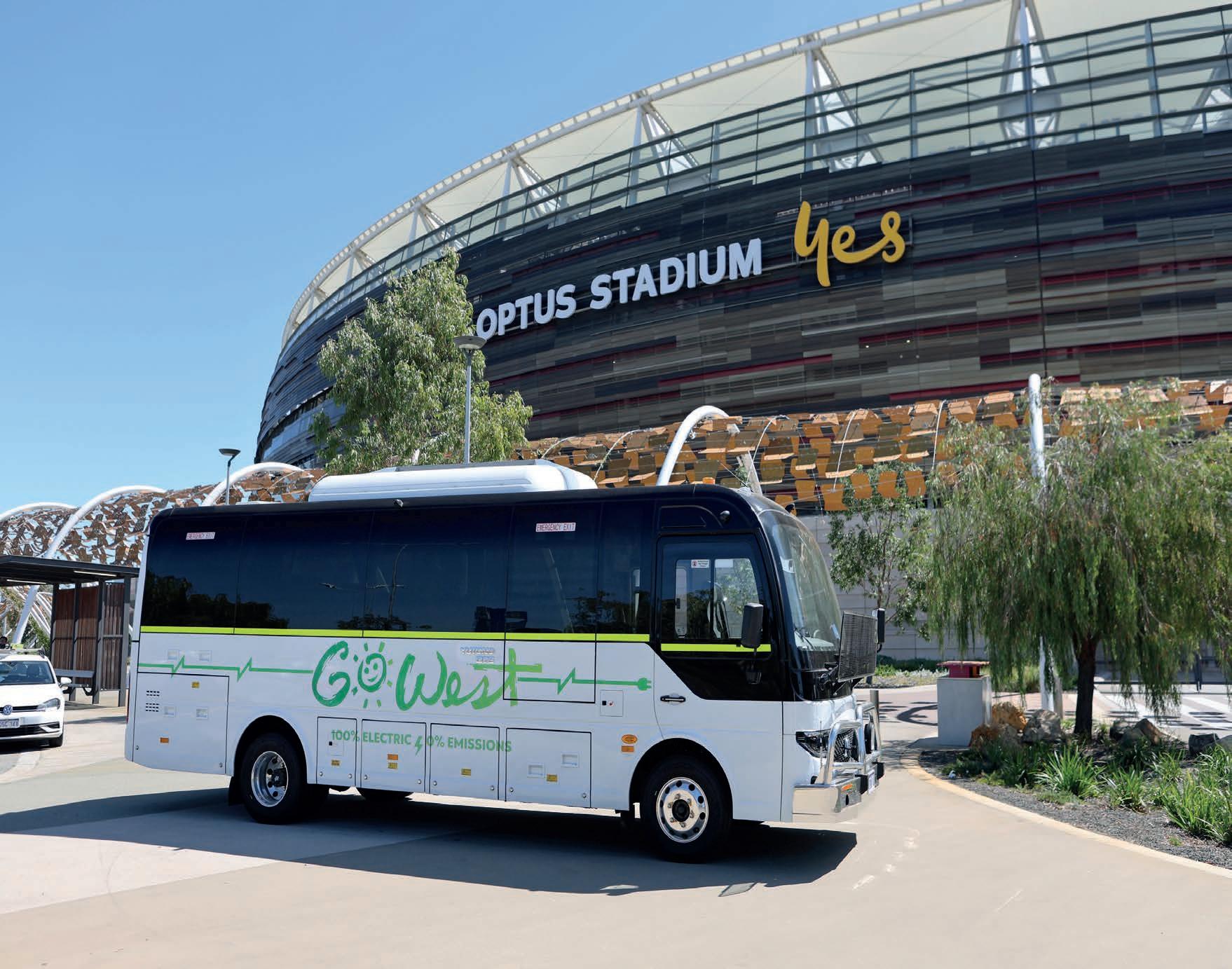
After
reaching historic heights in WA last year, Yutong is already enjoying an incredible start to 2025.
Sean Mortell finds out what else is on the way for the brand out west
For Yutong’s Western Australian operations, 2024 was a landmark year.
While overall the Yutong brand continued to grow all around the country, its rise in recent years is reflected best out west, with the state’s Yutong branch recording more than 100 new bus deliveries for the year.
Through a combination of Yutong’s global technology and the Bus Centre WA’s local prowess, the pair has gone from strength to strength in the state.
“The contributed growth in 2024/25 was a result of continued trust in the Yutong brand within
the WA bus network,” Yutong Bus Centre WA business development and operations manager Scott Lane told ABC.
“Our ability to supply vehicles due to local stock holdings and constant stock order from factory provides our customers with the confidence that we can meet delivery expectations far superior to other brands.”
Throughout 2024, the evidence of Yutong’s rapid growth out west allowed the team to continue building its operations. By the first quarter of this year, Yutong Bus Centre WA had doubled its staff levels when
Above: Yutong Australia’s WA branch has excelled in the past 18 months, delivering more than 100 units in 2024
compared to halfway through last year.
The result was Yutong celebrating its most successful year to date in the state, exceeding all expectations and KPIs. If this wasn’t enough, the brand closed out a historic year in WA with another major win in the final months.
“We also secured the majority of the state’s School Bus Services (SBS) contracts for 2025,’ Lane says.
“This is a true reflection of the dedication and hard work of our small but growing team.”
When it came to tendering for these highly sought after contracts, a popular nifty member of Yutong’s


growing Australian model range proved lucrative.
“The Yutong D7 model provided an option to customers that enables slightly larger capacity than what our competitors are offering,” Lane says.
“It also comes factory painted in orange and green SBS colours at no extra cost, while the warranty for the D7 is class leading at five years and 200,000kms.
“Add in new Euro 6 Cummins technology and improved safety technology and it’s a strong option for school contracts.”
Mastering the unique requirements of Western Australia’s bus industry is no easy feat. Whether it be buses for urban routes, school runs and mining applications or charter coaches for
outback tours, a range of vehicles are required to cater to the diverse operations in the massive state.
Lane says Yutong Bus Centre WA has excelled in a variety of areas by partnering with some of the largest transport providers in the state, as well as single bus owners operating in the mining and resources, school bus, tourism, charter and local council and government sectors.
This expansive focus has meant Yutong’s WA operations aren’t riding on the coattails of a massive 2024. Instead, the brand has already delivered half of last year’s quota of new vehicles by the end of the first quarter of 2025, showing that 2024 may just be the start of an upwards trend in the west.
Above: The WA centre for
is already off to a hot start in 2025, with 50 per cent of last year’s sales already being reached in the first quarter of this year
Below:
A new and improved facility is set to be a reward for the Yutong Bus Centre WA
“2025 has started off with a bang, with the C12 and D7 models sharing the bulk of deliveries,” Lane says.
“This was mostly seen in the School Bus Service bus orders, with some hitting the mining and touring sectors.
“The D7 model in particular has proven to be a favourite over competitors in this segment due to improved technology and safety, driver and passenger comfort. With the three Yutong models (C12, C10 and D7), we are able to offer a transport solution to the majority of operators.

“The success of Yutong’s dedicated models to the Australian market is represented by sales across all forms of bus transport.”
Lane says this year presents “amazing opportunities” for the entire state’s bus industry, as various sectors continue to move towards net zero electric bus options. With Lane saying charging infrastructure is continuing to improve in WA, the Yutong Bus Centre is prepared to support this important change in the industry through the sale of its D7E and C12E models.
“2025 has seen a massive increase in customer enquiries for our C12E and D7E models,” he says.
“The increased interest for 2025 was predicted as larger operators and mining sites have been actively investigating and investing in improved infrastructure to meet the charging application required.
“With the fast-approaching net zero deadlines coming up for many companies, the Yutong Bus Centre WA is well placed to provide green energy solutions within WA.”
In the mining sector, Yutong’s depth of technology has proven to be a gamechanger, with various systems offering unique options for operators. Whether it be Yutong’s Electric Architecture (YEA) or Yutong Electric Safety System, the safety and
now operating in some of Australia’s harshest conditions, including in the Port Hedland and Tom Price mining districts. So far, the feedback on the C12E and D7E’s performances are all positive.
“Yutong has been very proactive over the past 12 months monitoring data from the vehicles and seeking constructive feedback from operators, drivers and passengers to further develop its technologies and
growth will soon pay off as Yutong prepares to open a new site in 2026 to cater for the state’s rapid rise.
“Yutong Bus Centre WA has committed to the development of a new site with the opening set to occur mid-next year,” Lane says.
“When complete, it’ll provide improved processes and aftersales support, factory technician training for clients service personnel, increased parts holdings and the






























































































































Consat Telematics is consistently ahead of the curve when it comes to bus and coach technology, having a finger on the pulse of emerging trends, writes Tiarna Condren
As cities expand and mobility demands grow more complex, the bus and coach industry faces a critical decision: evolve or be left behind.
Public transport systems around the world are racing towards electrification and digitalisation, with one particular company quietly powering much of the shift behind the scenes.
Consat Telematics is known worldwide for its intelligent public transport systems. With cutting-edge telematics technology, real-time data intelligence and a deep understanding of mobility ecosystems, the company has played a large part in transforming how cities move.
“When Consat started building digital solutions for buses in 1989, few people were thinking about data-driven transit,” Consat product manager Adam Armstrong told ABC “Fast forward to today, and the company supports over 34,000 vehicles globally – including more than 2,500 electric buses, a number that’s rising fast.”
Over the past three decades, Consat has remained at the forefront of the electric movement, mainly
through its deep involvement in Norway and Sweden’s transportation landscape – two countries that are recognised as global leaders in electric mobility.
As these countries have spearheaded the shift toward electric buses, Consat’s technology has played a critical role in ensuring smooth operations.
The company’s advanced telematics solutions provides operators with real-time insights into battery performance, charging cycles and route efficiency. This vital data has enabled transport providers to maximise uptime and reliability.
“We were there from the start, working side-by-side with operators and agencies as they figured out how to run electric buses day to day,” Armstrong says.
“We have since spent years testing out the technology, upgrading it and perfecting it, completely redefining how fleets operate.”
Beyond Norway and Sweden, Consat has expanded its expertise across Europe, North America and beyond, supporting a variety of transport authorities and private operators in their electrification efforts.
The company’s solutions are now
Above: The system empowers bus operators and drivers to deliver safer and more reliable bus journeys for commuters
integral to electric bus fleets in cities worldwide, optimising energy consumption, reducing emissions and helping operators overcome the challenges of transitioning from diesel to electric vehicles.
“Now, as we expand across the likes
Below: Consat product manager Adam Armstrong

Transport for NSW and Transport for Brisbane.
One of the company’s most successful products is the Consat Vehicle Computer (CVC01), an advanced vehicle communication gateway computer.
In the realm of electric buses, Consat’s telematics system offers comprehensive solutions designed to optimise vehicle performance and energy consumption. One of the key features is the ability to manage and schedule charging processes effectively.
By analysing bus schedules and operational requirements, the system prioritises charging for specific vehicles, ensuring they are fully charged and ready for service at the required times. This strategic approach helps in balancing loads and reducing costly charging peaks.
“Battery management is one of the biggest wins for operators,” Armstrong says.
“As more and more operators bring electric vehicles into their fleets, it’s imperative that they are managing their operating costs and keeping up to date with maintenance. This system helps them achieve this with ease.”
Another significant aspect of Consat’s system is climate control management through pre-conditioning. In regions with high ambient temperatures, such as Queensland, the system can activate the bus’s air conditioning while the vehicle is still connected to the charger. This pre-cooling ensures that the bus maintains a comfortable temperature from the start of its route without depleting the battery’s energy
Consat’s system also extends to its driver console, offering coaching tools that promote efficient and sustainable driving practices.
By collecting and analysing data on driving patterns, the system provides feedback to drivers in real-time and end of trip, encouraging behaviours that enhance energy efficiency and passenger comfort. This feature not only improves operational performance but also contributes to the longevity of the vehicle’s components.
“One of our other big focus areas outside of electromobility is driver assistance,” Armstrong says.

“Driver coaching is a big thing. How they need to drive an electric bus is quite different to a diesel bus, with a unique set of rules and requirements for each.
“Not only can this technology help manage behaviours that could affect the usability of the buses, but it also helps with recruiting and maintaining drivers.
“When a new driver joins a company, one of our first thoughts is what assistance can we give them? How can we make this transition easier for them?”
By addressing both common and complex navigational challenges, the system empowers bus operators and drivers to deliver safer and more reliable bus journeys for commuters.
Specifically designed to meet the requirements of bus operators, the purpose-built system takes into acc ount bus dimensions like length and height, allowing operators to input and update routes in real time. This ensures adaptability to changes in
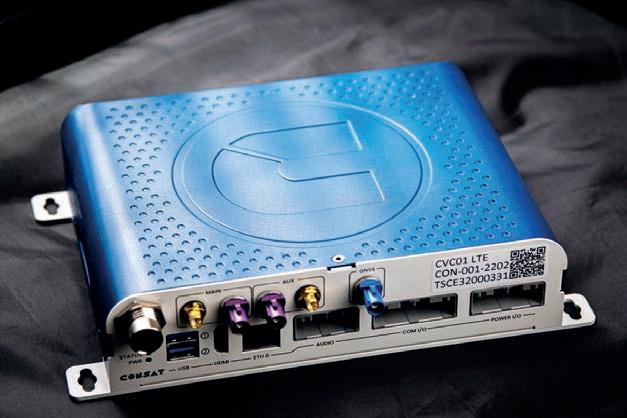
minimising wrong turns and route deviations.
One of the biggest challenges Consat faces is integration with different vehicle types and brands, particularly ensuring seamless compatibility across different markets.
“When you look at electric buses, each manufacturer has a different set of requirements and is built differently,” Armstrong says.
“While the base is usually similar, constant changes to regulations and upgrades means we have to be on top of our game to ensure our products can be compatible.
“So, in order to achieve this, we work locally with Australian bus manufacturers and international chassis and body makers to ensure we are in the know and can adapt our solutions.”
While the technology often gets the spotlight, Armstrong says the people behind the scenes are the true stars, calling Consat a “knowledge company”.
“There’s a number of people on our team that have been there since the beginning of Consat, who have a very good understanding of our product and the industry,” he says.
“The company has its finger on the pulse and works with a mentality that public transport matters. We’re helping cities and communities move smarter, cleaner and better.
“When it comes down to it, operators know that we deliver on what we promise.”

Luminator Australia is continuing to reshape bus and coach technology, now offering a comprehensive suite that is easing the stress for operators
Over the past three decades, technological advancements have reshaped everything from the way buses are powered to how passengers experience their daily commute.
Real-time bus tracking and contactless payments have made public transport journeys easier, and safety features like collision avoidance systems are helping to prevent accidents.
Advancements in the transit industry seem to move faster than ever and there is one technology company that has always forecasted the upcoming trends and been one step ahead to continually enhance the passenger experience.
The Australian arm of Luminator Technology Group has been providing and supporting technology products to the local market for over
20 years. Luminator has continued to provide the industry with a wealth of public transport solutions making its way into buses across the country.
“While the Luminator brand has seen global success in both the destination and passenger information equipment space, our focus now is adapting these products for the Australasian customer,” Luminator Australia senior manager of operations Anthony Goodman told ABC
“We have successfully implemented lightweight destination signs and CCTV cameras systems. Our recently deployed camera mirror system has also been a particular success with customers, greatly improving driver safety and awareness around the bus, in all environmental conditions.
“Now, we are introducing our web-based software suite that is set to combine various passenger
Above:
The web-based software suite provides operators with a one-stop shop for all of Luminator’s leading capabilities
information functionalities into the one system, called the Luminator Software Suite.”
The concept of a combined suite system emerged when Luminator globally was inspired to provide a one-stop shop for all its leading capabilities. The idea was for Luminator Suite to combine the main functions that the company provides into one clear dashboard.
Prior to the Luminator Suite system, the company offered its product range as individual solutions for operators, with separate systems pertaining to content management, presentation creation and fleet management.
“As it previously stood, each solution was offered as a separate application on a computer in the depot, where only one individual could use it at a time,” Goodman says.
“This was quite restrictive, as well as

a risk to the organisation. If that single computer malfunctions, the transit agency has lost all their destination and passenger information data.
“Luminator Suite allows multiple people at the depot to have access to the system and make changes when required.
“We are focused on bringing operators to that next level and ensuring that as technology evolves, they are included and evolve as well.”
Luminator Suite combines all Luminator’s best solutions into one system, from system administration, destination editor, operations and maintenance, content management and even a presentation creator.
Operators can access all the information through a singular browser and control it all via a web-based application.
“The benefits are truly endless. We have created a centrally controlled browser that makes operating our systems not just possible, but incredibly efficient,” Goodman says.
The Luminator Suite’s most significant innovation is its ability to eliminate traditional operational constraints. Control centres can now deploy location-based presentations, advertisements, emergency notifications or delay information directly to specific vehicles, without requiring them to return to the depot. This remote access capability represents a fundamental shift in how operators manage their digital communication systems.
Real-time monitoring of all on-board Luminator equipment provides operators with instant verification and proof of play for advertising content. Operators no longer need to physically track down buses to update or verify content, as everything can be managed seamlessly through a single web interface.
“It can all be deployed through remote access, meaning presentations, advertising and videos can be sent directly to certain vehicles in real-time without them needing to return to the depot,” Goodman says.
“Customers don’t have to worry about their technology when the suite is running.”
By providing a centralised, reliable,
and verifiable system, Luminator is not just offering a technology solution, but re-imagining the entire ecosystem of transport information management.

Although it is an exciting new update to Luminator’s Australian equipment catalogue, the system is tried and tested globally, particularly in the US market.
“We have seen success with Luminator Suite overseas and know that after conversations with local operators in Australia, we can tailor our solution to ensure our platform delivers precisely what they need,” Goodman says.
“This isn’t a one-size-fits-all solution. Operators can customise their system, selecting only the modules that align with their operational priorities.
“As an example, the Destination Editor module is web based. The buses do not need to be connected to a central computer for this module.
“For an operator, this removes the risk of losing the application at the depot level, yet still provides a cost -effective way for the operator to update the bus files, via USB.”
Current Luminator destination files used by customers can be exported directly into Luminator Software Suite, removing the need to recreate any historical information.
“We have created a platform that grows and adapts with their evolving technological needs,” he says.
By offering this adaptable approach, Luminator is positioning itself as a forward-thinking technology partner, ready to support the Australian bus and coach
Above: Luminator is const antly evolving its products to meet the needs of the industry
industry’s digital transformation.
Along with Luminator Suite for the passenger information system offering, Luminator also provides and supports vehicle CCTV systems and Electronic Camera Mirror Systems locally.
With the release of new local standards for buses relating to driver safety, Luminator is focused on a range of new products and functionality to support the requirements of the industry.
“As a supplier that has been in the industry for over 20 years, we need to constantly update our products and services to ensure our customers are provided with high quality, reliable solutions that will be supported by us locally,” Goodman says.
Below: Luminator also offers passenger information systems, CCTV systems and camera mirrors
For further information on the solution and the benefits it will provide your operation, please do not hesitate to contact


Celebrating 80 years in business, Royans Coachworks proves that maintaining customer loyalty is the key to success, writes Tiarna Condren
In an industry where service matters as much as skill, Royans Coachworks has built more than just a reputation – it’s built relationships.
For generations, customers have returned, not just because of the company’s expertise in repairing and restoring heavy vehicles, but because of the trust it has forged along the way.
Founded in 1944, Royans began as a family-run business with a simple mission: to get heavy vehicles back on the road safely and efficiently. Over the decades, the company has grown into an industry leader that has expanded its servicing capabilities to suit various needs within the industry.
As one half of the combined Royans Coachworks, Coachworks has played a large part in this diverse success, bringing decades of experience to the repair giant.
“After joining with Royans back in 2020, we’ve been able to expand our reach and capabilities, with
our customers benefiting from a wider network of locations, faster turnaround times and even more specialised expertise in bus and coach repairs,” Royans Coachworks branch manager Scott Isaacs told ABC
“Now, as Royans Coachworks celebrates 80 years in the business,
beginning to expand its transport accident repair, spray painting and other capabilities.
“We have been working really hard to build on the brand and offer our customers an unparalleled service experience,” Isaacs says.
“We want to be able to cover as much ground as possible, and that


easier access to repair services across the country, reducing downtime and improving convenience.
While continuing to offer quality accident repairs, refurbishments and refinish services, the bus and coach repair company also continues to develop its services in the retrofitting of major components. This includes the installation of onboard facilities such as restrooms and seating solutions.
Royans Coachworks also offers industry support in auto electrical services including the repair and installation of electrical components as well as audio visual equipment and supply of audio visual systems.
“These are some of our core services and those that we want to continue building moving forward,” Isaacs says.
“Customers can come to us to a wide range of projects or ideas, and we will strive to make it a reality for them.”
Retrofitting has also become a large part of the company’s offerings, particularly in regard to wheelchair accessibility and Disability Discrimination Act (DDA) compliance.
“The industry is constantly evolving, and changes will always need to be made to buses to ensure they are kept up-to-date and fit certain criteria,” he says.
“The retrofitting of wheelchair accessibility solutions is a big part of what we do, and it’s become a major growth area for us.”
With the rise of zero emission buses (ZEB) and technology, the heavy vehicle industry is entering a new era, which Royans Coachworks is more than equipped to tackle.
Recognising that the future of transport will require new skills, technology and repair methods, Royans Coachworks technicians undergo continuous training to handle repairs in all areas including ZEB, ensuring they understand the complexities of high voltage systems, battery safety and new structural materials.
“Fleets are changing, and we wanted to make sure we were evolving alongside them,” Isaacs says.
“We’ve invested in our training and

equipment so that we can support our clients as their fleets make the switch.”
Many of the company’s branches have been equipped with specialised repair bays, diagnostic tools and safety protocols tailored to electric vehicles, with the business working closely with manufacturers and industry bodies to stay ahead of evolving technology and regulatory requirements.
While Royans Coachworks has seen a fair amount of change in past few years, one thing has remained constant – its dedication to customer service.
Many of its customers have been with them for generations. Fleet managers who relied on the business decades ago now see their successors doing the same, trusting the company not just for its technical expertise, but for its consistency and customer-first approach.
One such loyal customer is Kangaroo Bus Lines. Offering a wide range of services for passengers, including school, urban and long-distance touring, outback Queensland tourist trips and cruise boat experiences, the operator prides itself on its commitment to customers and safety.
“We strive to provide safe, dependable and professional services to our customers, and a lot of that relies on who we choose to work with,” Kangaroo Bus Lines CEO Darren Webster told ABC
“We have been working with Coachworks for almost three decades now. They do all our
major smash and accident repairs and certain modifications, like seatbelt modifications, wheelchairs, anything like that.”
The relationship began back in the ‘90s when Webster’s father Darryl and Isaac’s father Evan became friends.
“They had known each other from back in the Denning days, and when the Isaacs family decided to start Coachworks, my father wasn’t far behind,” Webster says.
“We were probably one of their first customers and have been there ever since.”
While friendships and loyalty can take a company far, Webster says it’s Royans Coachworks commitment to excellence that keeps him coming back.
“They do quality work that is second to none,” Webster says.
“They truly care about the customer and the outcome and put everything into it. That’s why we keep coming back.”





• 2 x 2015 Scania K440EB
• 13.5m body
• 50 Styleride lap sash seat belted recliners in leather,
• Thermo King auto heat/ cool A/C + Drivers A/C
• 2 door entry, mid toilet,
• Full service history,
• plus more,
• Travelled 575-590,000km
$285,000.00 +GST each

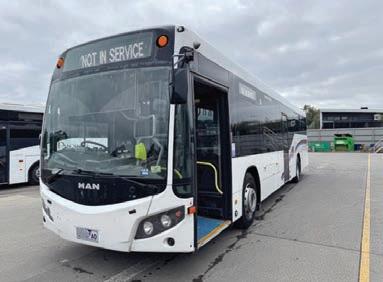

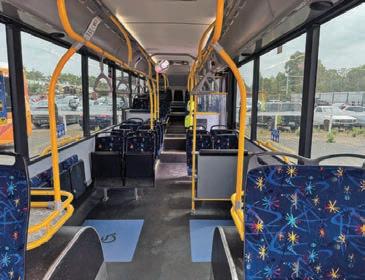
• 2012-2022 MAN 18/19-320 automatic chassis
• Volgren and Custom bodies
• Air conditioned
• 42-46 passenger plus standees
• 2 door
• Electronic destination signs
• School lights
• Travelled between 90-855,000klms
• Complete service history
• Plus more Prices from $135,000.00 +GST – $395,000.00 +GST each

Be sure not to miss out on an opportunity to attend these fantastic in-person events

APRIL
APRIL 30-MAY 1
PTAANZ Melbourne Symposium
APRIL 24
BusVic Regional Conference –Hamilton & Ballarat
MAY
MAY 5-9
BusNSW Regional Seminars (Northern NSW)
MAY 16-17
BusSA Annual Conference
MAY 19-22
BusNSW Regional Seminars (Southern NSW)
MAY 30-31
TasBus Annual Conference
JUNE
JUNE 01
TasBus Conference
JUNE 14
QBIC Regional Forum – Gympie
JUNE 15-18
UITP Summit
JULY
JUNE 11
QBIC Future Leaders Luncheon
JULY 18
BusWA BCI Bus Show
AUGUST
AUGUST 2
QBIC Regional Forum – Chinchilla
AUGUST 22
BusNSW NextGen Leaders Forum
SEPTEMBER
SEPTEMBER 11
QBIC Regional Forum – Gold Coast
SEPTEMBER 15-17
BCA Conference
OCTOBER
OCTOBER 1-2
BusNSW Member Conference
OCTOBER 4–9
Busworld Europe
OCTOBER 22
PTAANZ Annual Conference and Gala Dinner – Brisbane
OCTOBER 29-31
BIC National Conference – Perth
NOVEMBER
NOVEMBER 14–15
QBIC Regional and Partner Forum – Cairns
NOVEMBER 21
BusNSW Platinum and Gold Partners Luncheon
NOVEMBER 22
QBIC Christmas Function
DECEMBER 1
BusNSW Xmas Function
Tasmania’s Metro bus drivers will soon feel safer onboard, with long-awaited security screens finally getting the green light from the National Heavy Vehicle Regulator (NHVR).
The $2.1 million safety screen project has received a first-of-its-kind exemption, signalling the design meets strict safety standards and can be installed in buses before the national safety standards are finalised.
“Following extensive consultation and field testing, we have settled on a design that we are confident meets the needs of both drivers and passengers,” Tasmanian transport minister Eric Abetz says.
“To avoid any unintended consequences, we considered a variety of factors that may affect

driver and passenger safety, including comfort, and the presence of any glare and blind spots.
“Every Tasmanian deserves to enjoy a bus ride without fear or threat to their mental and physical wellbeing.”
The security screens were co-designed by Metro, unions and
Artificial intelligence cameras have been installed on some of Adelaide’s busiest roads in an Australian-first trial.
The first of its kind in South Australia, the software aims to improve road safety and traffic flow during peak periods, connecting to traffic management centres to automatically adjust traffic signals.
The cameras have been installed at key locations at Penfield, Paradise and two roads at Old Noarlunga.
In Adelaide’s northern suburbs, traffic build-up and dangerous rear-end collisions have reduced since the cameras were installed last year.
Previously, drivers attempting to exit the Northern Expressway onto Heaslip Road were able to bank up to dangerous levels. In some cases, motorists were forced to queue onto the expressway where several rear-end
collisions occurred.
Since the installation, the artificial intelligence cameras have been able to successfully identify and respond to
industry, and the NHVR, and will soon be installed in a staged roll-out by local supplier Havnadip Bus Repairs.
The $2.1 million project is a part of a broader $8.1 million Tasmanian government investment to support Metro.
“As part of our 2030 Strong Plan for Tasmania’s Future, we are committed to addressing anti-social behaviour on buses,” Abetz says.
“As we have repeatedly said, if you commit violence against our bus drivers, we will throw the book at you.
“The new screens will join an existing suite of security measures including arrangements with Tasmania Police, CCTV cameras on all buses, and internal security and safety programs.”
operate until the queue length on the exit ramp is reduced.
“The Malinauskas state government is embracing the very latest technology to deliver a safer and more reliable road

system at two more locations along the
While smart ticketing has been slowly filtering out into major cities across the country, regional areas have so far missed out on the growing trend. Until now.
Following successful trials in Bathurst and Dubbo, more than 400 town bus services across regional NSW will soon benefit from smart ticketing on its buses, with Wagga Wagga being the first to jump onboard the NSW government’s Contactless Ticketing Program.
In the coming months, 21 local buses in the area will be fitted with the tap and go payment technology, bringing the region in line with metropolitan areas where people have been able to pay without cash for years.
This technology means most passengers will now be able to use their smart phone, watch or debit/ credit card to pay for their fares.
“It will provide streamlined travel options for passengers wishing to pay fares with cards or devices but importantly, those who wish to pay by cash will still be able to do so, delivering a diversity of choice which will hopefully encourage more

communities to receive the new technology in coming months, with the program expected to be completed by the end of 2027.
“The Minns NSW government has heard people in regional communities who’ve told us they want to be able to pay for
The
passengers now paying without cash since launching the trials.
“The trial technology will now stay permanently in Bathurst and Dubbo and we will progressively roll out the same technology to other communities across the state,” Aitchison says.
implementation of smart ticketing on Brisbane City Council buses marks the end of its roll out on south-east Queensland public transport

After facing multi-million-dollar lengthy delays, smart ticketing is now available across the whole of south-east Queensland.
Above: Passengers can now t ap and go using their phones. Image: Bus Queensland
Customers can pay for their bus rides using contactless Visa, Mastercard or American Express credit or debit cards, cards stored in the digital wallet of smartphones, smart watches and other wearable devices.
“The new ticketing system is already available to customers on all Southeast Queensland (SEQ) trains, ferries, trams and all bus services covering the Gold Coast, Sunshine Coast, Ipswich, Moreton Bay, Logan and Redlands areas,” a Translink spokesperson told ABC “Some Brisbane City Council
bus customers may have noticed a change on the ticket readers recently, as equipment has been progressively switched on in the background as part of the project’s readiness procedures.”
The smart ticketing trial in Brisbane has faced ongoing setbacks, with the rollout on services initially expected to be completed by 2023.
The Queensland government initially pledged $371 million to the smart ticketing trial, before announcing early this year its budget had blown out by an additional $60 million.




Shepparton, Wodonga, Swan Hill, Ouyen, Leongatha and Bairnsdale. Hamilton and Ballarat Regional Conferences are scheduled to occur on April 24, 2025.
At the conferences, BAV President Stuart Locke from Seymour Coaches opened the meetings and introduced the suppliers present to BAV members.
Stuart Dawson from BAV provided updates on the DTP school bus forms pack, emergency management plans, road safety condition reporting, school bus centre reviews, BAV’s safe bus travel program, accessing the CPV portal and long service leave.
Oscar Goodwin from BAV updated all in attendance on industry development issues, including women in transport, anti-social behaviour on the network, new seat belt rules, NTC and NHVR reform, skills pathways and bike racks for buses.
fires, the remit of the Commission for Children and Young People and its regulatory role in the special school bus operating environment, bus driver accreditation and conditions, changing your business entity from a partnership to a company, cyber security, Privacy Act changes and changes to the Award and Enterprise Agreements. Chris Lowe provided members with an update on the government’s plans to transition the contracted fleet to zero emission buses, a summary of the outcomes of DTP’s 23/24 MZF tender and DE’s special school bus contract term.
On Friday March 7, BAV held its inaugural Supplier’s Forum. As part of its strategic plan penned in 2024, BAV resolved to do more for its Supplier Partners and Associate Members and holding a Supplier’s Forum was one of the key initiatives of that plan. The
the industry works.
Around 30 BAV Associate Members and Supplier Partners were provided insights into the Victorian bus industry’s composition, the regulatory environment, the legislative environment, the metropolitan and country operating and contracting environment, special school buses, how the service contracts and ceiling price mechanisms work, current government policies, industry trends and the plans the government has for transitioning the contracted fleet to zero emission technology. Everyone was provided with a quick lunch at the end. Feedback from the Supplier’s Forum was extremely positive to the extent that BAV will repeat the event on March 24 for those who could not attend on March 7.
Thank you to all those that attended and for your continued support of BAV. We are very happy that so many found this event beneficial.








The winner of ABC ’s Best Bus April comes courtesy of Owen Hedley and a fleet of Ventura coaches
on an eerie Wednesday morning.
It seems nighttime shots were all the rage this month, with Brad Collins’ entry of a Firefly No11 parked up for a break at Keith 24/Seven Roadhouse vying for the top spot, while Aaron West’s shot of a Murrays BCI Proma also utilised the dark to his advantage, providing the perfect opportunity to show off some of those LEDs.
James Mitchell transported us to New Zealand with his entries, showing off the range of buses that hit the busy roads.
Despite the tight competition, it was ultimately Owen Hedley who came
out on top, his dynamic shot of four Ventura buses a clear winner.
“I took this shot while parked up in front of the Giant Koala in Dadswells Bridge, Victoria,” Hedley says.
As the winner of Best Bus April, Hedley has received a free 12-month subscription to ABC Magazine, while the winning photo is also being shown off as ABC’s Facebook cover photo for the whole of the month.
Don’t forget to send through your Best Bus photos for May and throughout 2025 via email and keep an eye on our Facebook page for more details!
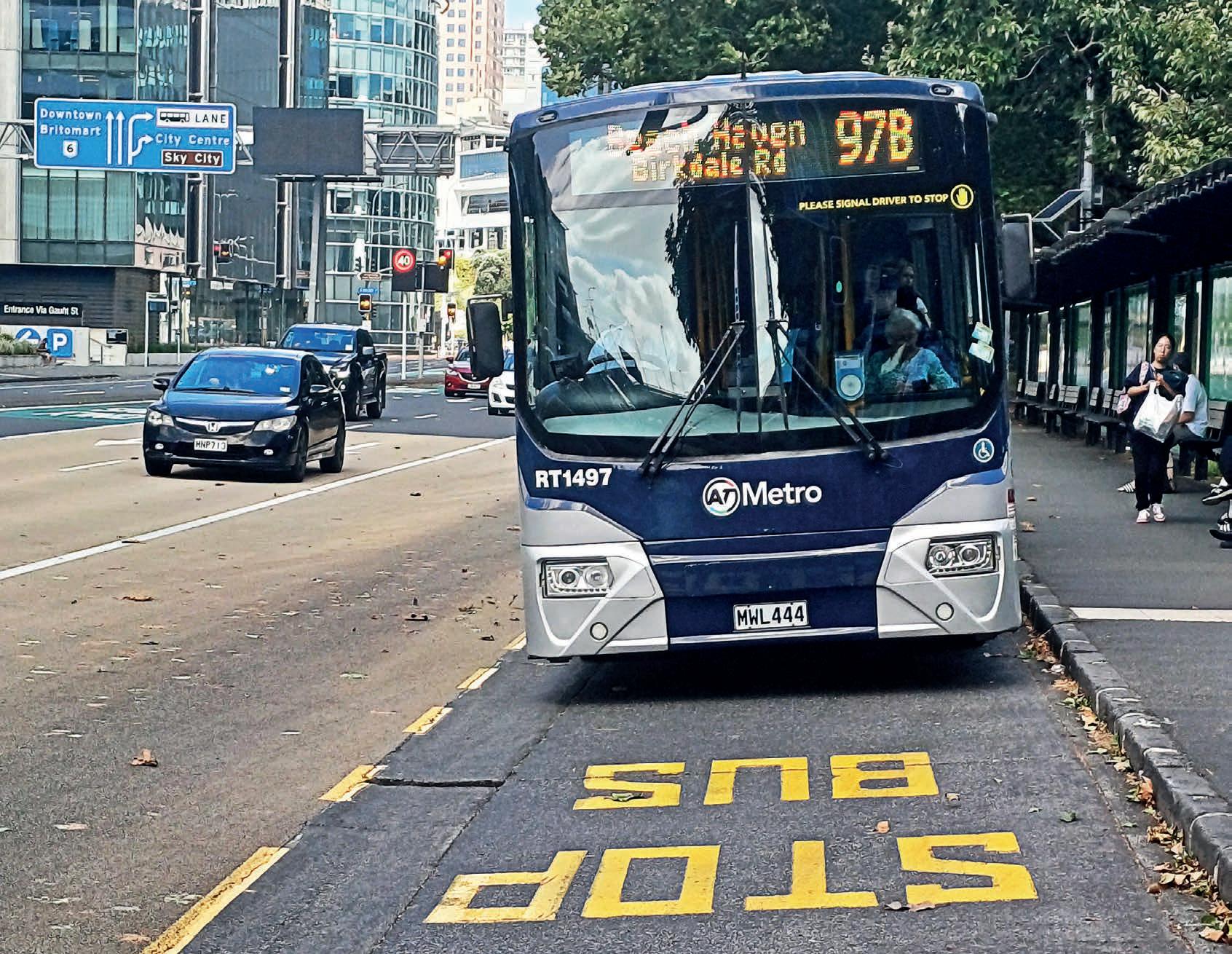
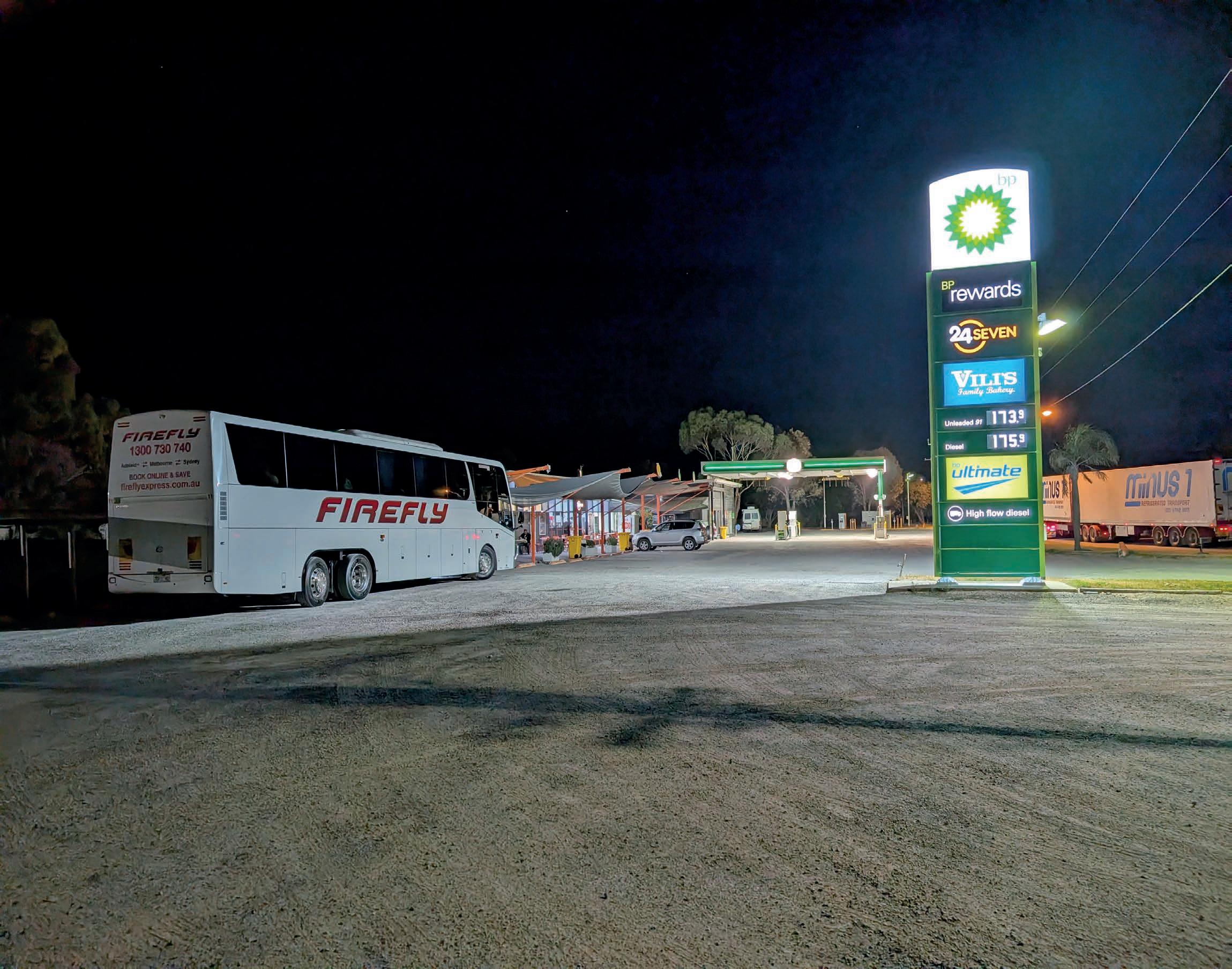



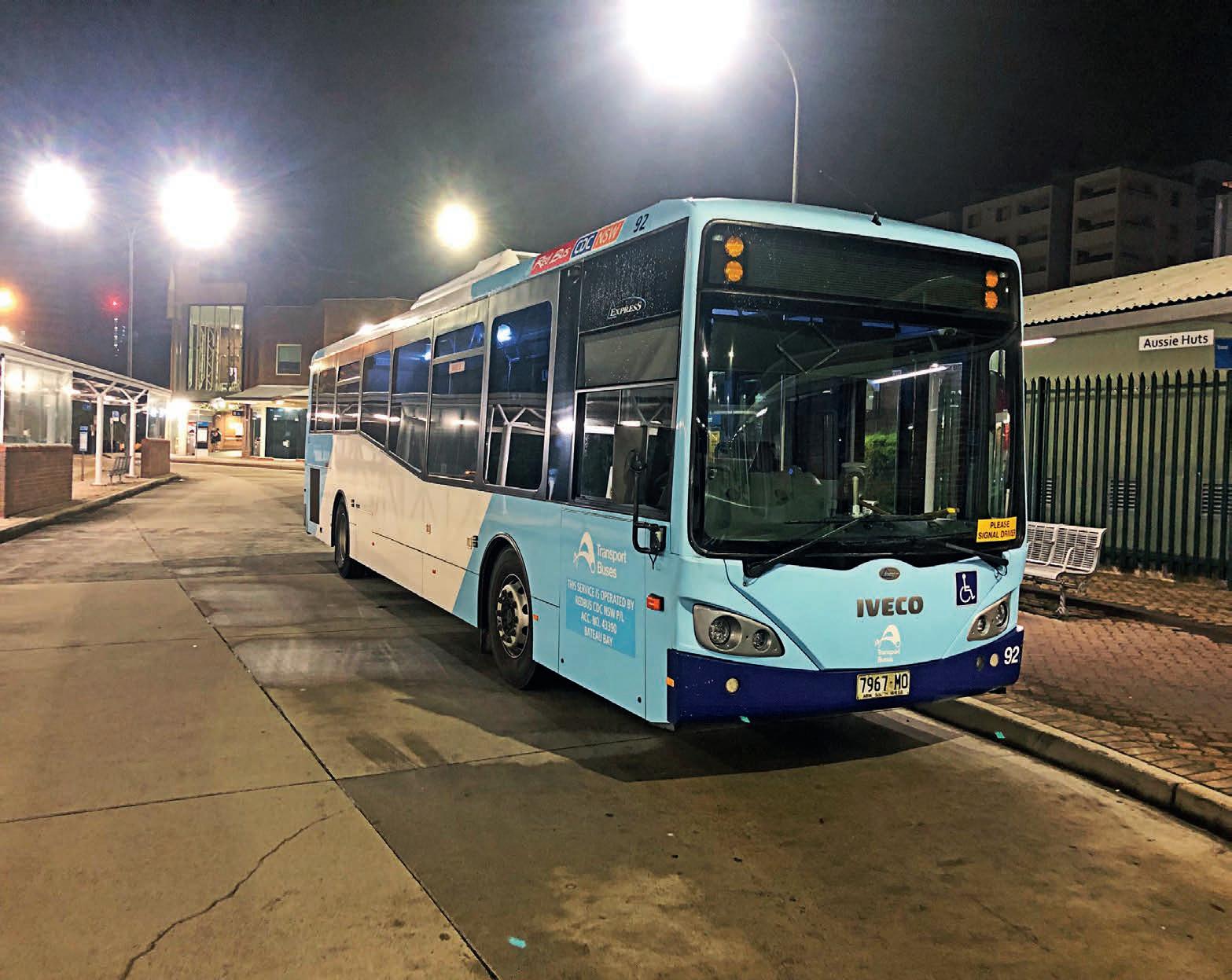

After a hectic start to the year for bus and coach deliveries, March’s numbers cooled to a more sustainable figure
The bus and coach deliveries have cooled in March, with a fast start to the year slowing last month with 159 deliveries recorded in February and 164 in January, March saw 123 units recorded for the month. Year on year, the March number falls just short of the 135 deliveries recorded in the same month last year.
When it came to the chassis market, Volvo was once again clearly the leader in the market for March, recording 45 units for the month. While it was 15 below its February efforts, it was nearly double the next best in Yutong, who had 27 deliveries in March including six D7s. Scania also had a strong month with the 24 deliveries, forming a strong top three. Custom Denning was a clear fourth with 15 units recorded, with I-Bus (five), MAN (four), BLK (two) and BCI (one) wrapping up the condensed market in March.
A tight tussle in the bodybuilder market still yielded the same results, as Volgren emerged as the leading supplier in the sector las month with
31 deliveries. Overall, Yutong claimed second with 27 deliveries, including six light bus units, while BCI had the 20 deliveries. Custom Denning was the next best outside of the top three with 15 deliveries, with Irizar (10) also reaching double figures. I-Bus had the five deliveries and Scania Higer the four, with the remaining 11 deliveries being shared by seven brands.
There was nothing close about the seating market for March, with McConnell’s 51 deliveries seeing it take the cake comfortably for the month. A strong month from Sege (28) saw it claim a clear second spot, with StyleRide (22) solidifying the top three. Yutong had the 16 deliveries to continue its consistency, while APM (five) and Marcopolo (one) brought up the rear of the market for March.
A changing of the guard occurred in the air-conditioning market, with Cling-Yutong claiming March’s top spot with 27 deliveries. Spheros rose into second with the 18 deliveries, as close competition saw the perennial leader in Thermo King slip to equal third alongside Coachair with the 17
Above: Volgren held off some challenges to once again claim top spot in the body builder market.
Image: Volgren
deliveries apiece. Hispacold wasn’t far behind on 13, with new entrant Husky claiming the five units. MCC (nine) stayed ahead of Songz and Valeo on five deliveries each, with Konvekta (four) and Denso (three) closing out the market.
A similar change was seen in March when it came to the state-based deliveries battle, as Queensland’s previous dominance was usurped by its state of origin rival. New South Wales claimed the honours last month with the 33 deliveries, leaving Queensland in second with 27. Victoria wasn’t far behind with 24, with Western Australia rising up with the 20 units recorded. South Australia (nine) had a strong month, with the ACT (nine) also rising, while Tasmania recorded the solitary unit.
When looking at the diesel and electric vehicle split, 27 of the 123 units delivered in March were electric, with Custom Denning (15) claiming top spot ahead of Yutong (nine) and Volvo (three). Out of the 96 diesel deliveries, Volvo (42) was clearly the leader ahead of Scania (21) and Yutong (18).
Therewasnothingclose abouttheseatingmarketfor March,withMcConnell’s51 deliveriesseeingittakethecake comfortablyforthemonth.A strongmonthfromSege(28)saw itclaimaclearsecondspot.
Achangingofthe guardoccurred,with Cling-Yutongclaiming March’stopspotwith 27deliveries.Spheros roseintosecondwith 18deliveries,asclose competitionsawthe perennialleaderin ThermoKingsliptoequal thirdalongsideCoachair with17deliveries.
Volvowasonceagainclearlytheleaderinthe market,recording45unitsforMarch.Whileitwas 15belowitsFebruaryefforts,itwasnearlydouble thenextbestinYutong,whohad27deliveriesin MarchincludingsixD7models.
BCIATGWA1BCICruiser10BCIME14tN/AREuro6 BLKN/ATAS1BLKBLKPresident2ME18.5t360REuro5 BLKN/AQLD1BLKBLKPresident2ME18.5t360REuro5 CustomDenningN/ANSW15CustomDenningCustomDenningME18t400L:RZero I-BusN/AVIC1IsuzuI-BusAustralasiaME8.7t190FEuro5 I-BusN/AVIC1IsuzuI-BusAustralasiaME8.7t190FEuro5 I-BusN/AVIC1IsuzuI-BusAustralasiaME8.7t190FEuro5 I-BusN/AQLD1IsuzuI-BusAustralasiaME8.7t190FEuro5 I-BusN/AQLD1IsuzuI-BusAustralasiaME8.7t190FEuro5 MANSurfsideBuslinesQLD2MANLE.19.330.RC2GlobalBusVenturesME19.5t330REuro6 MANFallsCreekCoachServiceVIC1MANIC.19.320.RR8CoachDesignME19.5t320REuro5 MANSchoolBusLogisticsWA1MANIC.19.330.RR8BLKAutoME19.5t330REuro6 ScaniaB&GChristianVIC1ScaniaK370CB4x2NBScaniaHigerME19.5t370REuro6 ScaniaBus&CoachInternationalQLD4ScaniaK320CB4x2NBBCIME19.5t320REuro6 ScaniaDepartmentforInfrastructureandTransportSA1ScaniaK320HB4x2LBBusTechME20.2t320REuro6 ScaniaDepartmentforInfrastructureandTransportSA2ScaniaK320HB4x2LBVolgrenME19.5t320REuro6 ScaniaHillcrestChristainCollegeQLD2ScaniaK360CB4x2NBScaniaHigerME19.5t360REuro6 ScaniaIrizarAsiaPacificQLD1ScaniaK320CB4x2NBIrizarME19.5t320REuro6 ScaniaIrizarAsiaPacificQLD1ScaniaK320CB4x2NBIrizarME19.5t320REuro6 ScaniaJointDefenceFacilityPineGapQLD1ScaniaK320CB4x2NBBCIME19.5t320REuro6 ScaniaPopesConsolidatedBusLinesVIC4ScaniaK320CB4x2NBBCIME19.5t320REuro6 ScaniaSC&LDisneyInvestmentsVIC1ScaniaK320CB4x2NBIrizarME19.5t320REuro6
ScaniaVenturaBusLinesVIC5ScaniaK320CB4x2LBVolgrenME19.5t320REuro6
ScaniaWBLVIC1ScaniaK360CB4x2NBScaniaHigerME19.5t360REuro6 VolvoFearnesInvestmentsNSW3VolvoB8RLEVolgrenME19t320REuro6 VolvoREOInvestmentsNSW3VolvoB8RLEVolgrenME19t320REuro6 VolvoMurraysCoachesQLD4VolvoB8RBCIME19t350REuro6 VolvoPortStephensCoachesNSW1VolvoBZLExpressME19tN/ARZero VolvoSinclairBusesNSW1VolvoB11RIrizarME26t450REuro5 VolvoMacquarieEducationalToursNSW1VolvoB11RIrizarME26t450REuro5 VolvoSeacliffCoachesNSW1VolvoB11RIrizarME26t450REuro5 VolvoForestCoachLinesNSW1VolvoB8RVolgrenME19t320REuro6 VolvoLinkSASA5VolvoB8RLEBCIME19t350REuro6 VolvoCDCQLDQLD1VolvoB8RLEVolgrenME19t320REuro6 VolvoKangarooBusLinesQLD1VolvoB8RLEBCIME19t350REuro6 VolvoCabooltureBusLinesQLD1VolvoB8RLEVolgrenME19t320REuro6 VolvoBusQueensland-WestsideBusCoQLD1VolvoB8RLEVolgrenME19t320REuro6 VolvoDarlingDownsTransitQLD1VolvoB8RVolgrenME19t330REuro5 VolvoPublicTransportAuthorityWAWA10VolvoB8RLEVolgrenME19t320REuro6 VolvoPublicTransportAuthorityWAWA2VolvoBZLElectricVolgrenME19tN/ARZero VolvoA1Tour&CharterSA1VolvoB8RMarcopoloME19t350REuro6 VolvoAl-TaqwaCollageVIC1VolvoB8RIrizarME19t320REuro5 VolvoColesCoachesVIC1VolvoB8RIrizarME19t350REuro6 VolvoNulineCharterVIC1VolvoB11RCoachConceptsME26t410REuro5 VolvoVenturaBusLinesVIC1VolvoB8RLEVolgrenME19t330REuro5 VolvoSwanHavenWA1VolvoB8RCoachConceptsME19t350REuro6 VolvoAlstonVIC1VolvoB8RIrizarME19t350REuro6 VolvoLangley'sCoachesNSW1VolvoB11RIrizarME26t410REuro5 YutongYutongBusCentreBrisbaneQLD1YutongC12YutongME18t340FEuro6 YutongYutongBusCentreBrisbaneQLD1YutongC10YutongME13.6t310REuro6 YutongYutongBusCentreBrisbaneQLD2YutongD7YutongME8t190FEuro6 YutongYutongBusCentreMelbourneVIC1YutongD7YutongME8t190FEuro6 YutongYutongBusCentreMelbourneVIC1YutongD7YutongME8t190FEuro6 YutongYutongBusCentreWAWA2YutongC12YutongME18t340FEuro6 YutongYutongBusCentreWAWA1YutongC12YutongME18t340FEuro6 YutongYutongBusCentreWAWA1YutongC10YutongME13.6t310REuro6 YutongYutongBusCentreWAWA1YutongC10YutongME13.6t310REuro6 YutongYutongBusCentreSydneyNSW1YutongD7YutongME8t190FEuro6 YutongYutongBusCentreSydneyNSW1YutongD7YutongME8t190FEuro6 YutongYutongBusCentreSydneyNSW4YutongC12YutongME18t340FEuro6 YutongYutongBusCentreSydneyACT9YutongE12YutongME18t350N/AN/A YutongYutongBusCentreMelbourneVIC1YutongC12YutongME18t340FEuro6 YutongYutongBusCentreMelbourneSA1YutongD7YutongME8t190FEuro6 YutongYutongBusCentreWAWA4YutongC12YutongME18t340FEuro6 YutongYutongBusCentreWAWA2YutongD7YutongME8t190FEuro6 YutongYutongBusCentreWAWA2YutongC12YutongME18t340FEuro6 YutongYutongBusCentreWAWA1YutongC10YutongME13.6t310REuro6 YutongYutongBusCentreWAWA1YutongC12YutongME18t340FEuro6 YutongWillungaCharterSA1YutongD7YutongME8t190FEuro6 YutongYutongBusCentreWAWA1YutongD7YutongME8t190FEuro6 YutongYutongBusCentreWAWA2YutongC12YutongME18t340FEuro6 YutongYutongBusCentreSydneyNSW3YutongD7YutongME8t190FEuro6 YutongYutongBusCentreSydneyACT7YutongE12YutongME18t350N/AN/A
AZF210.6MCC43–––––X–McConnellBCIYN AAllison212.36Spheros57–––X–––SegeBLKYN/A AAllison212.36Spheros–53––––X–SegeBLKYN/A N/AN/A212Spheros––41––X––McConnellVenturaNY ASIsuzu28.3Songz32–––––X–APMSASDoorsYN ASIsuzu28.3Songz32–––––X–APMSASDoorsYN ASIsuzu28.3Songz32–––––X–APMSASDoorsYN ASIsuzu28.3Songz32–––––X–APMSASDoorsYN ASIsuzu28.3Songz32–––––X–APMSASDoorsYN AZF212.5Valeo––46––X––McConnellVenturaNN AZF212.5Coachair57–––––X–SegeSMCYN AZF212.3Valeo57–––––X–McConnellBLKAutoYN AZF212.5Konvekta58–––––X–McConnellN/AYN AZF212.3MCC57–––––X–SegeN/AYN OpticruiseScania212.5Hispacold45––––X––McConnellN/ANN OpticruiseScania212.5Hispacold45––––X––McConnellN/ANN AZF212.3Konvekta58–––––X–StylerideN/AYN AZF212.3Hispacold58–––––X–SegeN/AYN AZF212.3Hispacold57–––––X–SegeN/AYN AZF212.5ThermoKing–53––––X–SegeN/AYN AZF212.3ThermoKing57–––––X–McConnellN/AYN AZF212.3Hispacold57–––––X–SegeN/AYN AZF212.5Coachair––44––X––McConnellN/ANN AZF212.3Konvekta58–––––X–McConnellN/AYN AZF212.3Coachair––47––X––StyleRideVenturaNY AZF212.3Coachair––47––X––StyleRideVenturaNY AZF212.5MCC–48–X––––SegeBCIYY AVolvo212.3Denso––49––X––StyleRideVenturaYY ASVolvo312.5Hispacold–48–X––––SegeIrizarYN ASVolvo314.3Hispacold–61–X––––SegeIrizarYY ASVolvo313.5Hispacold–57–X––––SegeIrizarYY AZF210-12.9Coachair54–––––X–McConnellSMCYN AZF210-12.9Husky51––––X––SegeBCIYY AZF210-12.9Coachair––43––X––McConnellVenturaNY AZF210-12.9Coachair51–––X–––SegeBCIYY AZF210-12.9ThermoKing––43––X––StyleRideVenturaNY AZF210-12.9ThermoKing––43––X––McConnellVenturaNY AZF210-12.9Coachair61–X–McConnellSMCYN AZF210-12.9ThermoKing––41––X––McConnellSMCYN AVolvo210-12.9Denso––32––X––McConnellVenturaNY AZF210-12.9Spheros57–––X–––MarcopoloMarcopoloYN AZF210-12.9Hispacold57–––––X–SegeIrizarYN AZF210-12.9Hispacold57–––––X–SegeIrizarYN ASVolvo210-12.9Valeo57–––X–––StyleRideSMCYN AZF210-12.9Valeo––44––X––McConnellVenturaNY AZF210-12.9Coachair57–––––X–McConnellSMCYN ASVolvo210-12.9Hispacold–49––X–––SegeIrizarYY ASVolvo313-14.9Hispacold–50––X–––SegeIrizarYY AAllison212.3Cling-Yutong57–––X–––YutongYutongYN AZF29.9Cling-Yutong–43––––X–YutongYutongYN AAllison27.7Cling-Yutong27–––––X–YutongYutongYN AAllison27.7Cling-Yutong40–––––X–StyleRideYutongYN AAllison27.7Cling-Yutong27–––––X–YutongYutongYN AAllison212.3Cling-Yutong57–––X–––YutongYutongYN AAllison212.3Cling-Yutong57–––X–––YutongYutongYN AZF29.9Cling-Yutong–43––X–––YutongYutongYN AZF29.9Cling-Yutong39–––––X–YutongYutongYN AAllison27.7Cling-Yutong40–––––X–StyleRideYutongYN AAllison27.7Cling-Yutong27–––X–––YutongYutongYN AAllison212.3Cling-Yutong57–––X–––YutongYutongYN N/AN/A212.4Cling-Yutong––44––X––StyleRideYutongN/AY AAllison212.3Cling-Yutong57–YutongYutongYN AAllison27.7Cling-Yutong27–XYutongYutongYN AAllison212.3Cling-Yutong83–X–McConnellYutongYN AAllison27.7Cling-Yutong28–X–YutongYutongYN AAllison212.3Cling-Yutong83–X–McConnellYutongYN AZF29.9Cling-Yutong43–X–YutongYutongYN AAllison212.3Cling-Yutong57–X–YutongYutongYN AAllison27.7Cling-Yutong27–XYutongYutongYN AAllison27.7Cling-Yutong27–X–YutongYutongYN AAllison212.3Cling-Yutong57–X–YutongYutongYN AAllison27.7Cling-Yutong27–X–YutongYutongYN N/AN/A212.4Cling-Yutong––44––X––StyleRideYutongN/AY
After 50 years in the public transport industry, Shane Butcher says he could still spend another 50 behind the wheel
For most people, a daily bus ride is just part of the routine. A way to get from point A to point B without stopping for fuel. Shane Butcher, however, views his daily bus ride as his lifelong adventure.
Celebrating 50 years in the industry, Butcher can still recall the day his passion for public transport began.
“My earliest memories are of standing on the seat of a Bendigo tram as a toddler, gripping the windowsill while shopping with mum,” Butcher told ABC.
“That moment ignited my love for public transport and I knew I wanted to be part of it.”
At just 14 years and 10 months old, Butcher began his career in May 1975, working as a tram conductor in Bendigo. By 1980, on his 20th birthday, Butcher took the next step, joining Melbourne’s tramways at Hawthorn Training Centre and becoming a driver in 1981.
“I was hooked from the beginning, always looking for the next way to get myself more involved,” he says.
“I wanted to follow that tram and public transport dream.
Melbourne was the Mecca, so to Melbourne I went.”
Over the next 18 years, he drove trams across Kew, Glen Huntly and East Preston depots, witnessing the evolution from conductor-assisted travel to driver-only operations.
In 1999, a new chapter began when he moved to Perth and traded tram tracks for buses. He joined the Transperth bus network as a driver, and with Swan Transit, became a fixture at the Canning Vale depot.
“I used to love catching buses and watching the drivers and having a chat with them. It seemed like a natural progression considering there were no trams in Perth,” he says. here ever since.”

Butcher has seen public transport transform, from manual ticketing to digital systems, heritage vehicles to modern fleets and the introduction of accessibility innovations that make travel easier for all passengers.
“Technology has changed so much, but the heart of public transport remains the same and that is getting people where they need to go safely and reliably,” he says.
Witnessing the changes in the industry for over five decades, Butcher says it is his passion for the job that has led him to last this long.

